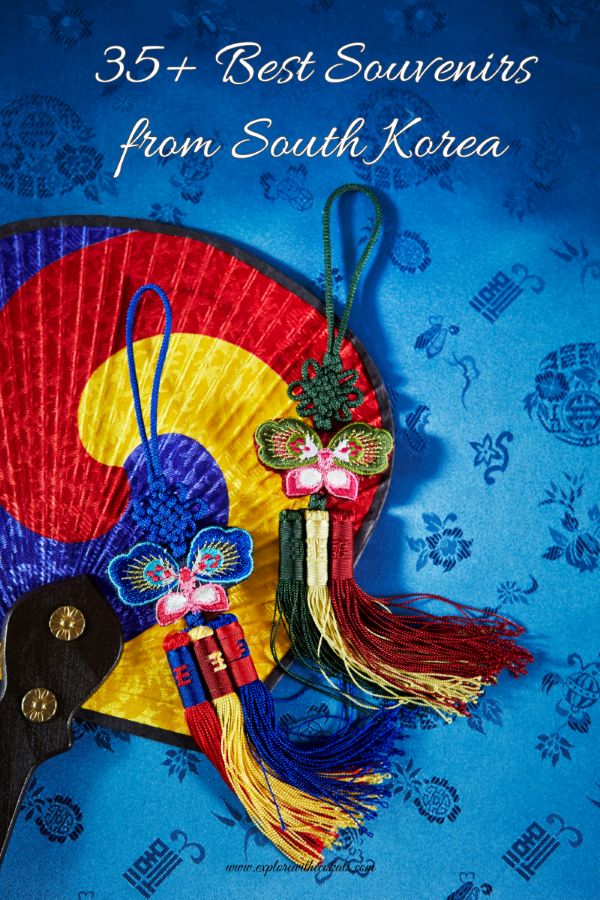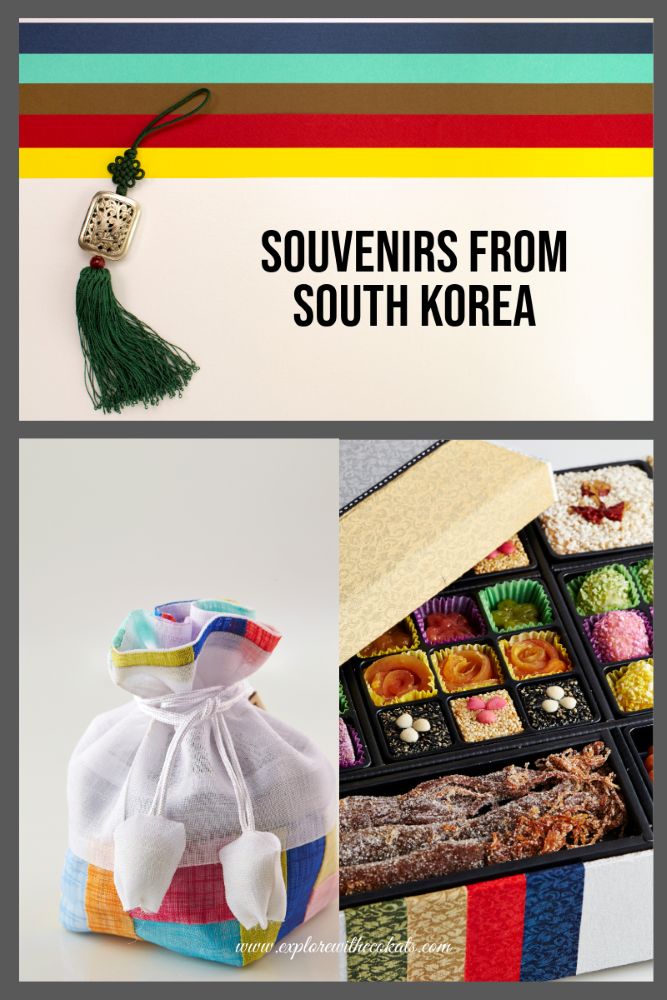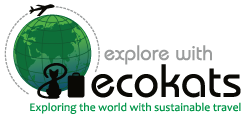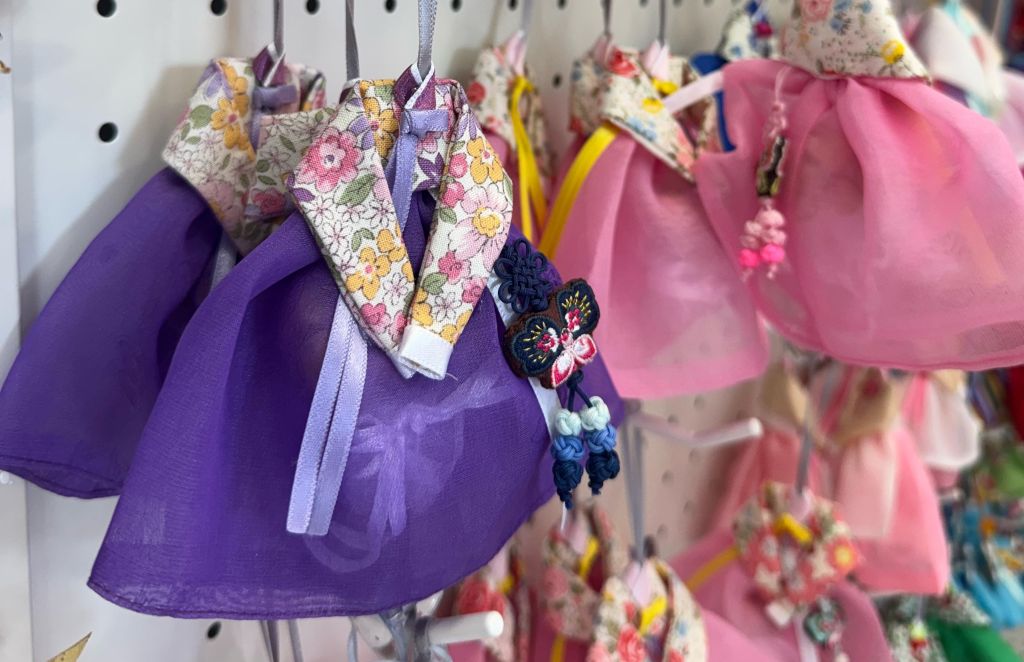Last Updated on May 7, 2025 by
Planning a trip to South Korea? Then shopping is probably at the top of your list! While purchasing skincare in Korea is the top priority, here is a list of the best souvenirs from South Korea to remember a trip of a lifetime or a gift to family and friends.
South Korea is a shopping paradise – from handmade artefacts to K-pop merchandise, from limited edition shoes to food and snacks, there is no dearth of things to buy from Korea.
If you love exploring the streets and purchasing souvenirs like me, then read on to make an informed decision based on my purchase. Whether you like functional items, fridge magnets, fashion, ceramics or good old ramen, here’s a list of all the unique, easy to pack and affordable korean gifts that will stand out!
Also, if you mention to friends that you are visiting Korea, everybody is expecting a gift from Korea.
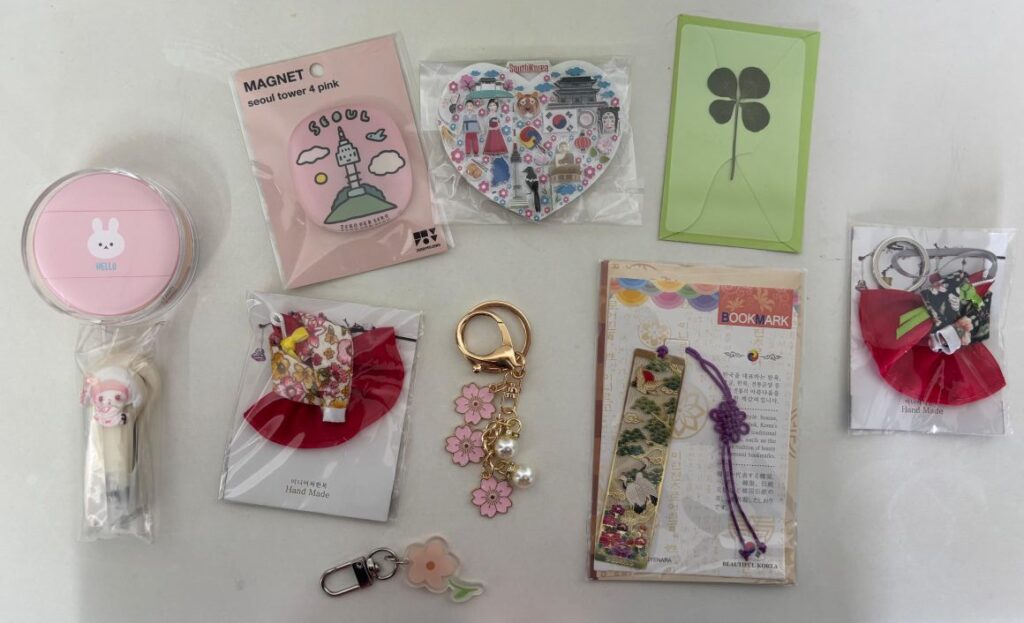
Table of Contents
THINGS TO BUY FROM KOREA | BEST SOUVENIRS FROM SOUTH KOREA
Beauty Products
Korea is famous for its innovative skincare and beauty products. I have heard tourists travelling to Seoul just for their beauty or skin treatments from their home country, and still finding it affordable.
Although it is completely up to you to get beauty treatments, if you’re short on time, you can indulge in skincare analysis and brands instead of a treatment. There are many clinics that offer free skin analysis and, based on that, recommend products. If you want to be sure, go for a paid skin analysis where a doctor looks at your skin and then recommends treatments and products.
If you are like me, who does not want to spend half a day in skin treatments, then go into any store and look for the most popular Korean skincare brands like Innisfree, Laneige, and Etude House, offering a wide range of sheet masks, sunscreens, serums, moisturizers, and makeup products. The staff also helps in informing the good products.
There is an Olive Young store on every street, so you can just pop in anytime during the entire duration of your trip and keep making purchases.
Besides Olive Young, you can find alternatives like Hemeko, Chicor, Mimiline, All Mask Story, Beauty Play, and TemTem, with different brands or prices. Even Korean pharmacy stores and convenience stores like Daiso, 7-Eleven and CU have skincare and beauty products.
Cost of skincare: 1,500 – 5,00,000 KRW (US$1 – 350) depending on products.
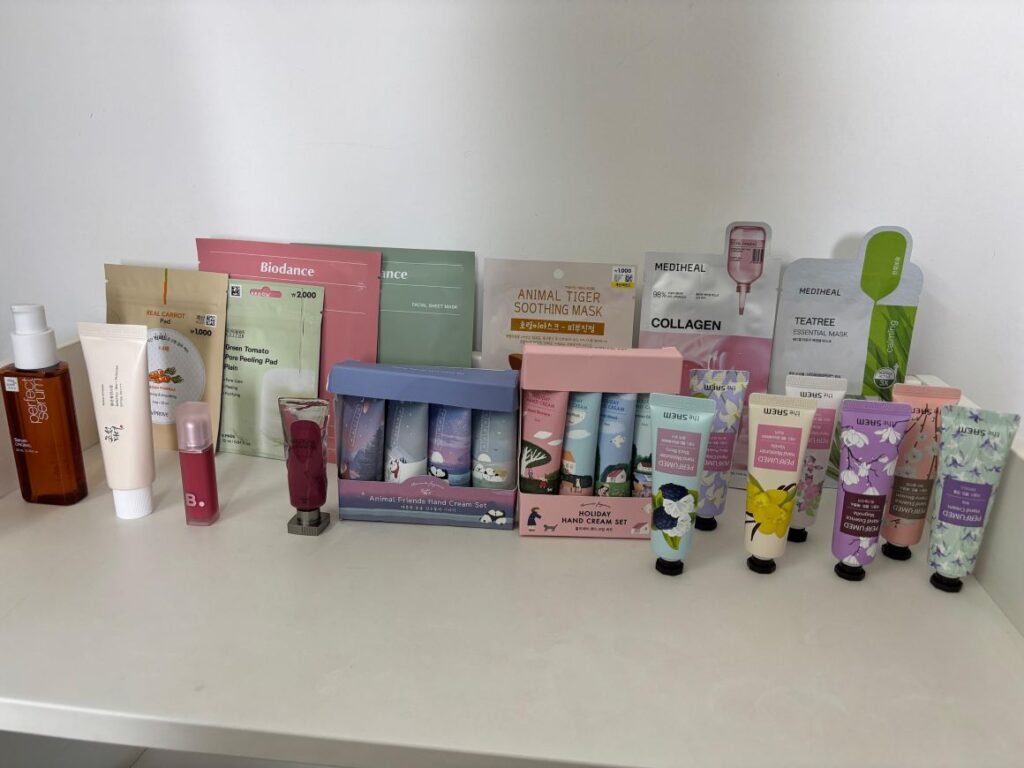
K-pop themed merchandise
The official merchandise cost and its shipping cost to the country of residence are almost the same. We have all been there.
So it makes sense to purchase all the official K-pop and K-drama merchandise while in Korea. If you can’t go to official flagship stores, just purchase them and get them delivered to your hotel for a fraction of the shipping cost.
There is also the option of purchasing your favourite singer’s or actor’s merchandise like posters, cards, bobble heads, keychains, files, and so much more. There are a few shops in the Myeongdong metro underground market that have amazing options.
Cost of K-pop themed merchandise: 2000 – 80,000 KRW (US$1.5 – 70)
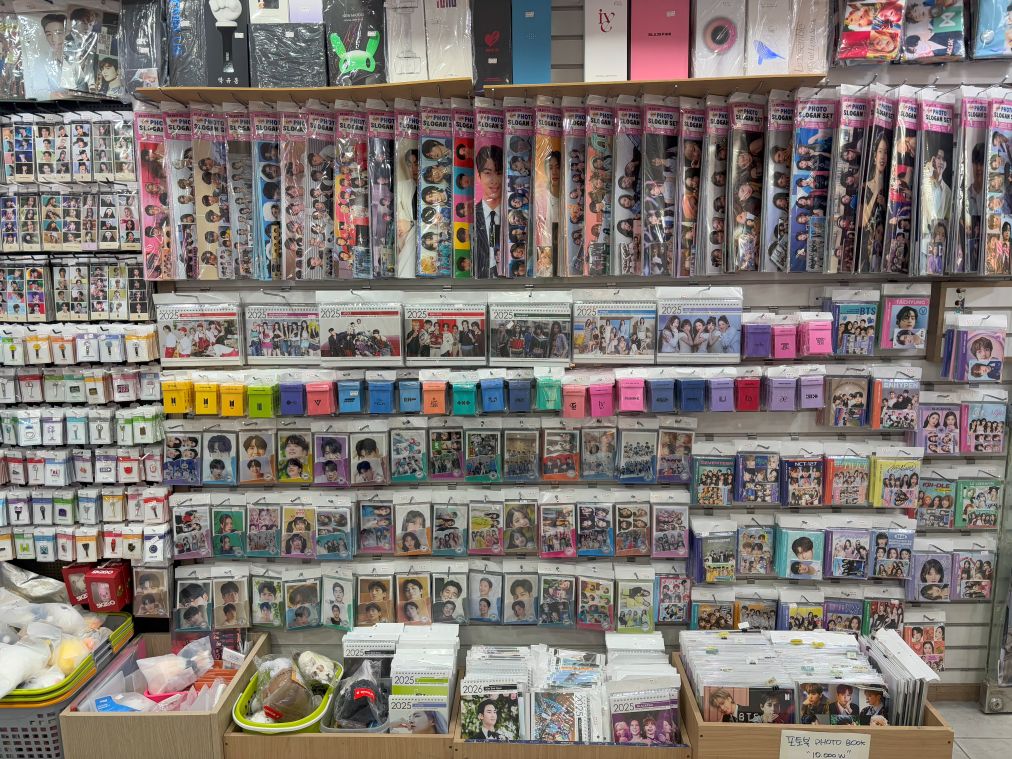
Embroidered purses
I had no idea about embroidery being a cultural identity in Korea. In earlier days, the traditional attire – hanbok, hair accessories and handkerchiefs used to have intricate embroidery. However, now it is limited only to purses.
Cost of embroidered purses: 5,000 – 15,000 (US$3.5 – 10)
Chopsticks
Chopsticks make for one of the best souvenirs from South Korea as they reflect the country’s unique cultural identity and daily traditions. Chopsticks used in daily life in Korea are stainless steel ones, often adorned with traditional designs. Bringing home a pair not only captures a piece of Korean heritage but also serves as a thoughtful, functional reminder of the trip.
For gifting purposes, wooden ones are available at a more affordable rate with a cover.
Cost of chopsticks: 5,000 – 30,000 KRW (US$3.5 – 21)
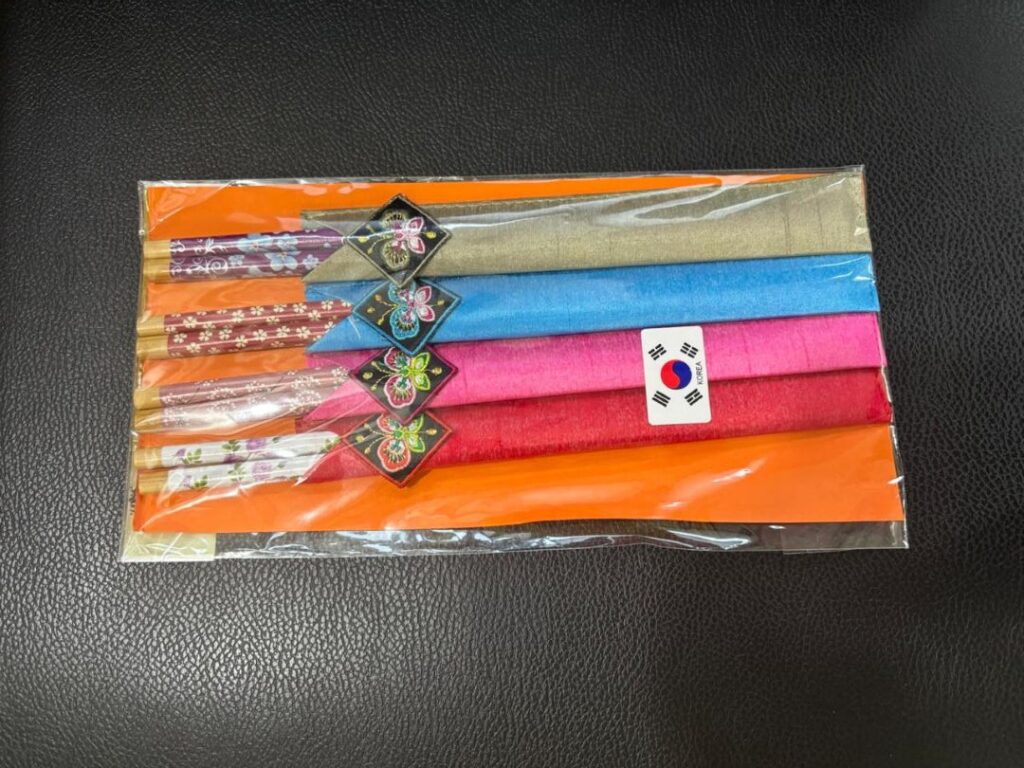
Socks
I found the most cute and intriguing variety of sock designs in Korea. Purchasing socks from Korea is popular because of their high quality, comfort, and quirky, stylish designs that blend fashion with fun. Korean socks are often affordable yet durable, featuring everything from K-pop idols to traditional patterns and cute characters, making them perfect as practical souvenirs or unique gifts.
There are generally good offers, making them tempting enough to purchase! Choosing the design is a task since you’d feel like buying them all.
Cost of socks: 1,500 KRW (US$1) for one pair and 10,000 KRW (US$ 7) for seven pairs.
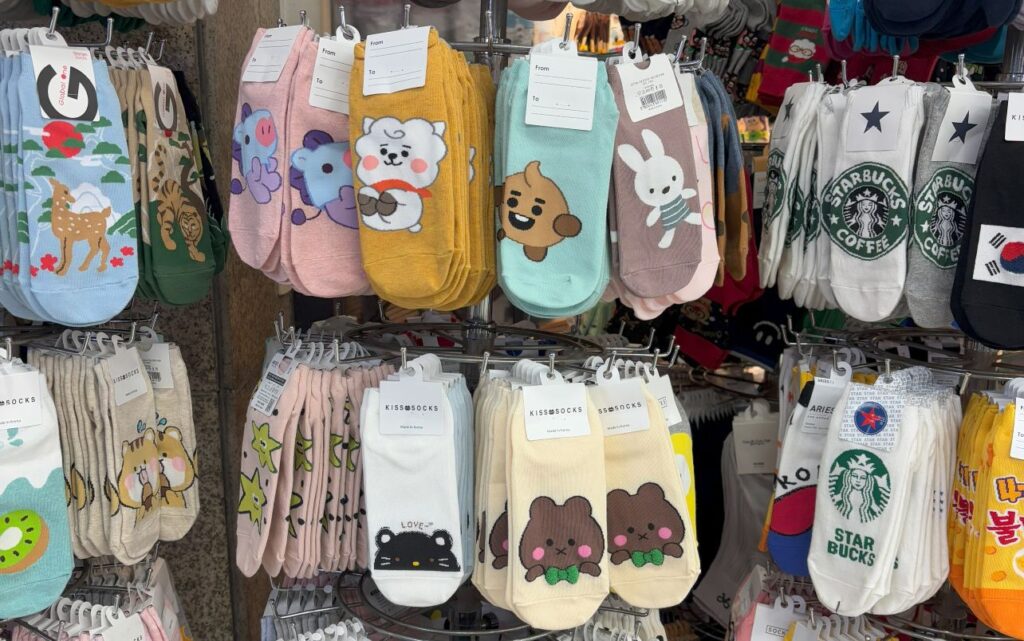
Made in Korea fashion and accessories
Designer wear, local brands, and global brands’ flagships are all available here. From malls to metro underground markets to flea markets, there are many options for purchasing clothes, bags, and accessories. All of these have high quality and are mostly durable.
I found Namdaemun Market to be a budget-friendly option for tourists. The Myeongdong Underground Shopping Centre is hands down one of the best shopping places in Seoul. It has all the trending fashion and accessories.
Many of the stores are open for 24 hours, offering tourists the luxury to explore the city in the morning and shop at night. Dongdaemun Market is open 24 hours a day, which is the country’s largest wholesale and retail shopping district. It boasts of 26 shopping malls, around 30,000 speciality stores, and over 50,000 manufacturers. Shoppers can find an incredible variety of products here, from silks and textiles to clothing, footwear, accessories, electronics, leather items, sports gear, office supplies, pet goods, and toys.
Cost of fashion and accessories: 1,500 – 50,000 KRW (US$1 – 35)
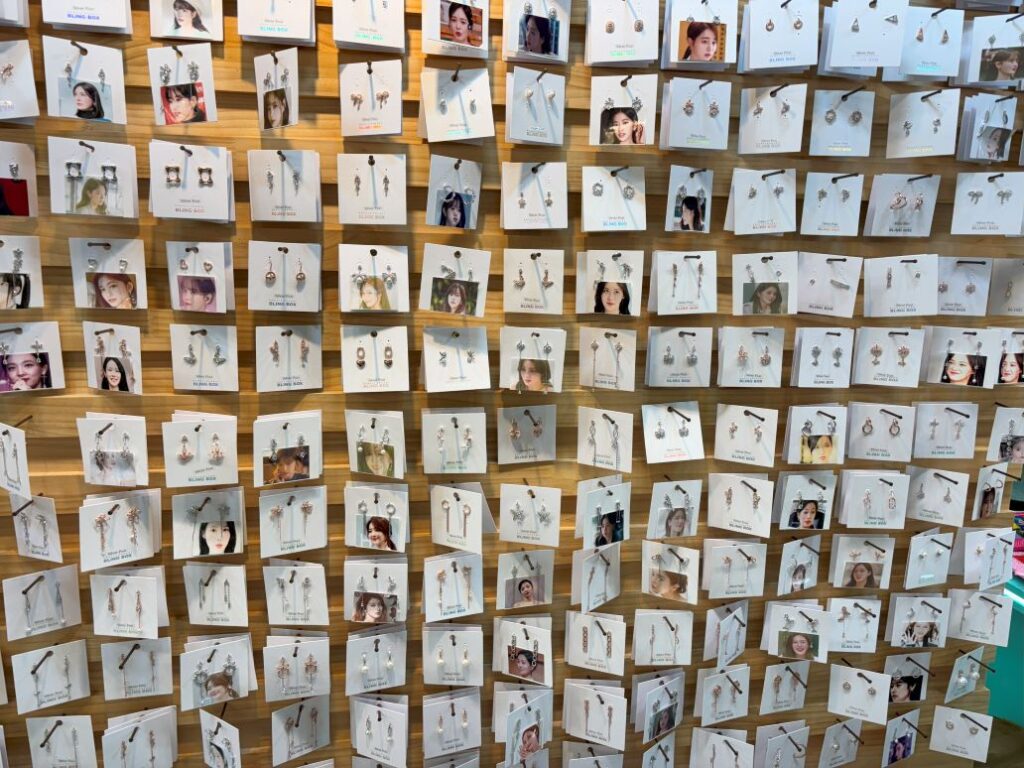
Ginseng Products
Korean ginseng, known as “insam,” is highly prized for its medicinal properties and is often referred to as the “king of herbs.” It is a popular and meaningful souvenir because of its renowned health benefits, premium quality, and cultural significance. The variety of ginseng aged for 6 years is known for boosting energy, enhancing immunity, and reducing fatigue.
Ginseng extracts are infused in many products and sold in the form of candy and jelly. It is also used in food items such as chicken broth. Many Korean cosmetics also use ginseng in their skincare products.
Note: Ginseng products can be carried in check-in luggage, strictly.
Cost of ginseng candy and jelly: 2,500 – 7,000 KRW (US$2 – 7), but the extract can go up to US$ 70-100 depending upon age and quality. Red ginseng is more expensive than white.
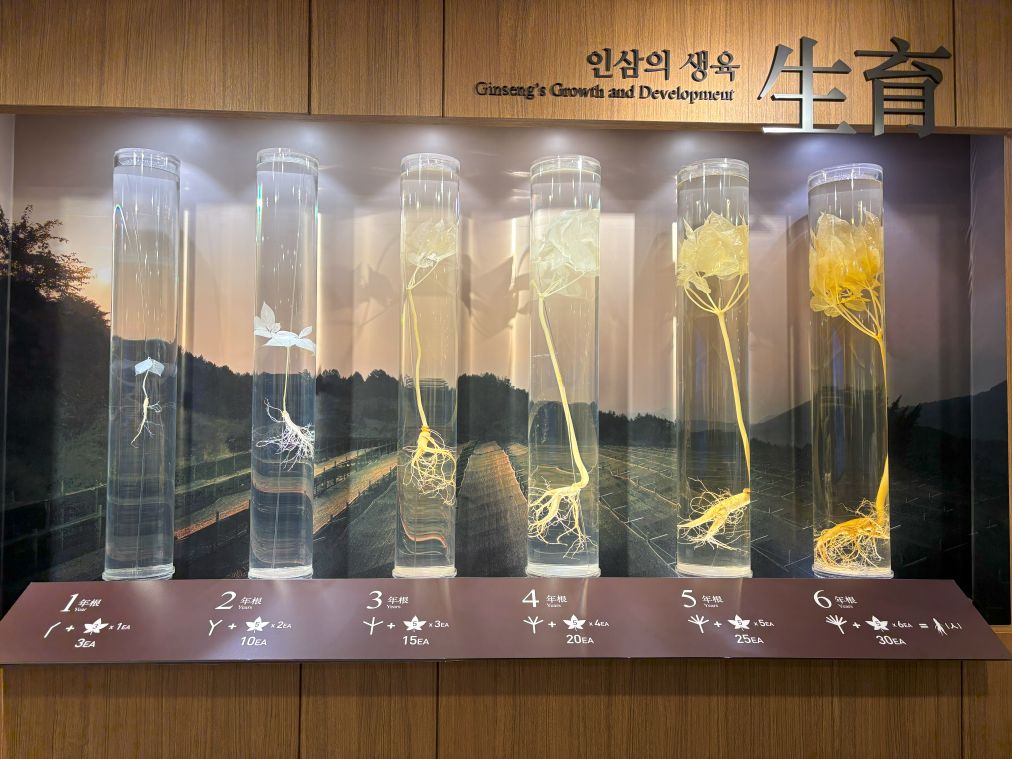
Buddha souvenirs
Buddhism is one of the main religions in Korea. Hence, many Buddha-related souvenirs are available outside of temples. Popular items include miniature Buddha statues, prayer beads, lotus flower-themed crafts, and incense sets. These souvenirs are made from natural materials like wood, bronze, or jade. Scrolls, mandala artwork, and temple-stamped amulets are also some of the options available.
Cost of Buddha souvenirs: 3,000 – 15,000 KRW (US$ 2.5 – 10)
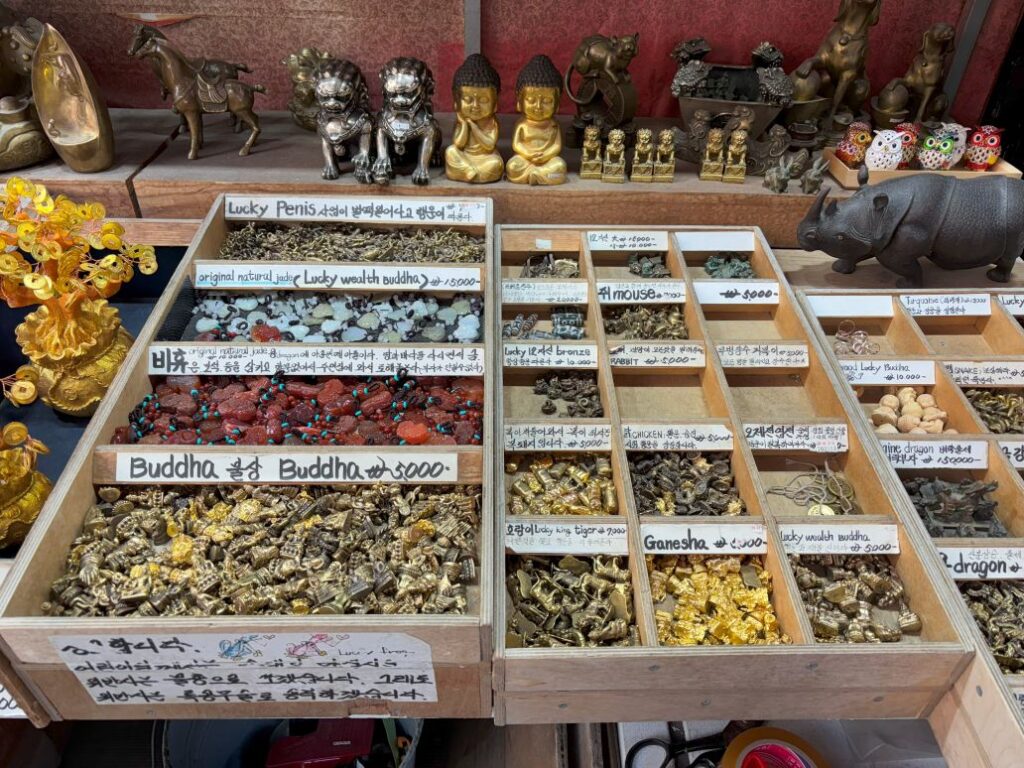
Korean Snacks and Treats
Traditional Korean snacks such as Yakgwa, Gosomi sweet crackers, and Choco Pie are popular delights cherished across generations. Yakgwa, a deep-fried honey pastry, offers a chewy, rich flavour; Gosomi crackers are light, crispy, and subtly sweet; while Choco Pie features a soft cake filled with marshmallow and coated in chocolate. These treats are commonly enjoyed during festive occasions, family gatherings, or simply as comforting everyday snacks.
Cost of Yakgwa: 5,000 – 15,000 KRW (US$3.5 – 10) depending upon the size and weight of the box.
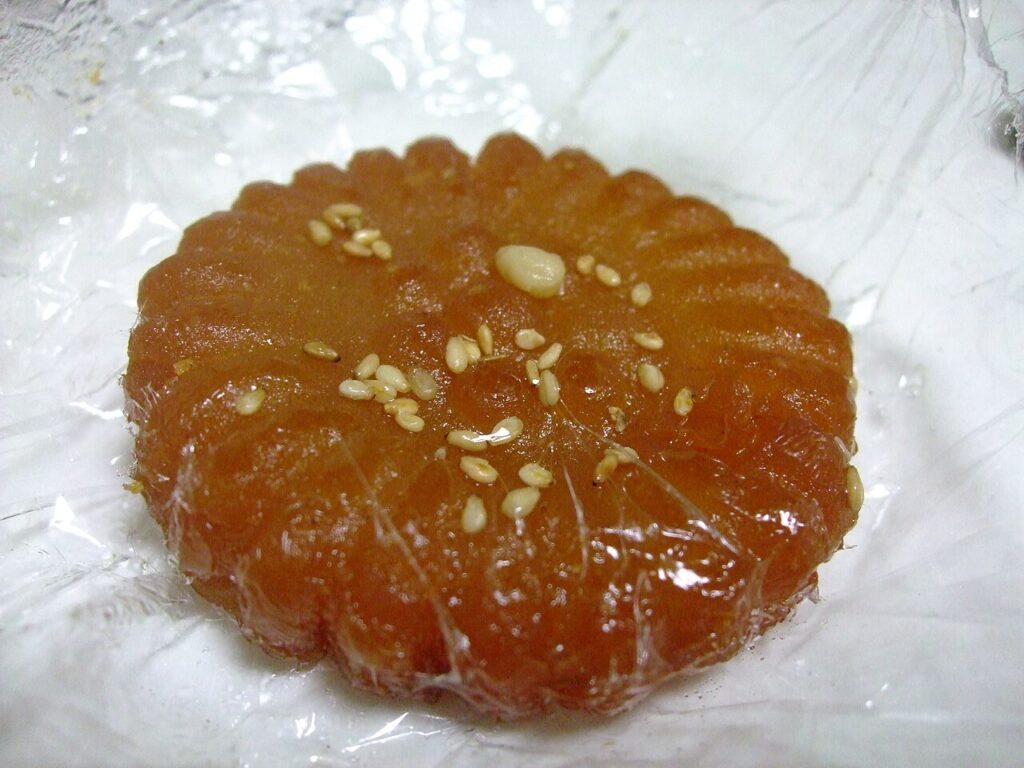
Flavoured almonds and nuts
Just like there are a million flavours (regular and wild) of Kit Kats in Japan, Korea has done it for almonds and nuts. Healthy But Awesome Flavours (HBAF) is the largest nut brand in Korea, with some unique and wacky flavours.
Their flagship store in Myeongdong, Seoul, attracts a lot of tourists thanks to its very design.
Cost of flavoured almonds: 7,900 – 30,000 KRW (US$ 5.5 – 21.5)
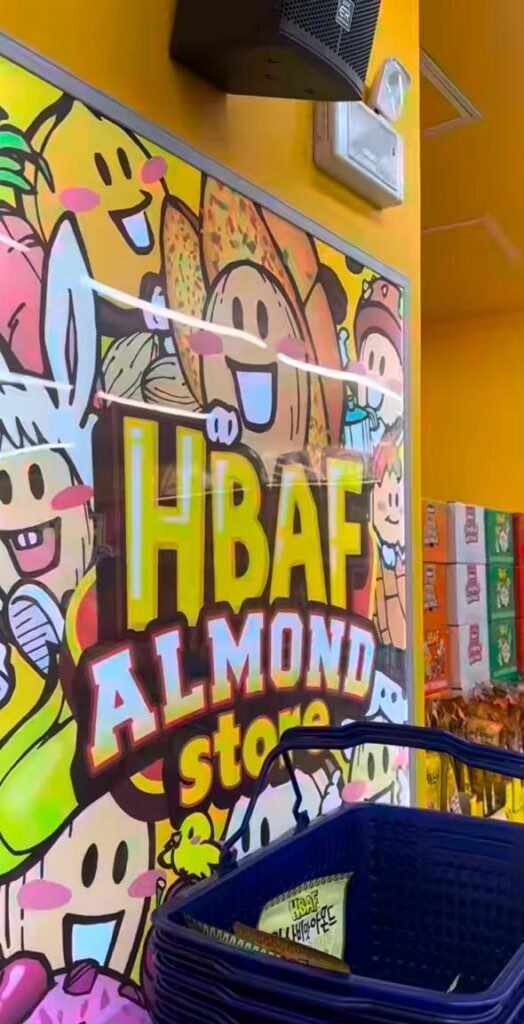
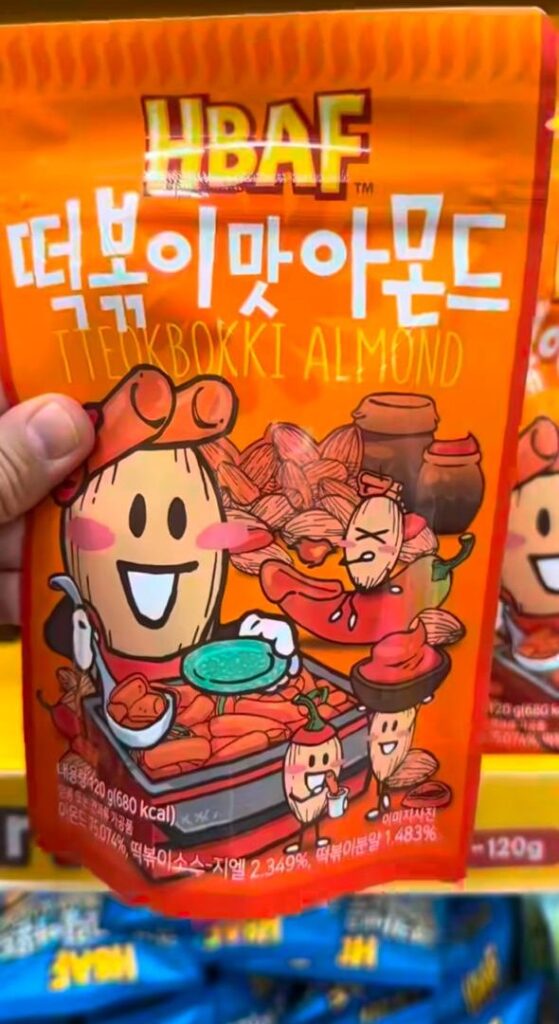
Traditional Tea
Tea is an important beverage in South Korea, just like it is in Taiwan, Japan and China. While the newer generation is the coffee drinking generation, tea still has a very important place in the traditional kitchen and the way it is served with every meal. This makes tea one of the best souvenirs from South Korea.
Immerse yourself in Korean tea culture with a variety of traditional teas like green tea (nokcha), barley tea (boricha), and citron tea (yujacha). Local tea shops and markets offer beautifully packaged tea sets and loose-leaf options, perfect for gifting or personal enjoyment. Celebrated for its subtle flavour, floral scent, and vivid green hue, this tea is commonly savoured during traditional tea ceremonies or as a soothing, everyday drink.
Cost of traditional tea: 5,000 – 30,000 KRW (US$ 3.5 – 21.5) depending on quality, type of tea and size of packing.
Korean Hanbok and Hanbok-Themed Souvenirs
Hanbok is the traditional Korean attire characterised by vibrant colours, intricate embroidery and elegant designs. These pastel-shaded outfits for both men and women look beautiful. Worn only on festive days and in weddings, the hanbok is making a comeback among tourists who want to embrace the culture of Korea.
Hanbok on rent is an amazing concept where visitors can rent it for a couple of hours, take pictures and return it. The rental places also ensure they dress up the tourists and offer hair and make-up services as well. If you love the outfit, you can purchase a hanbok to take back home as a unique souvenir from South Korea.
If not, consider purchasing a miniature hanbok for decoration in your home. I found a cool and unique hanbok souvenir – a wine bottle cover, shaped in hanbok!
Cost of Hanbok: 200,000 – 700,000 KRW (US$140 – 480), depending on materials and size.
Cost of renting a Hanbok: 20,000 to 50,000 KRW (US$14 – 35)
Cost of Hanbok-themed souvenirs: 15,000 – 30,000 KRW (US$10 – 21.5)
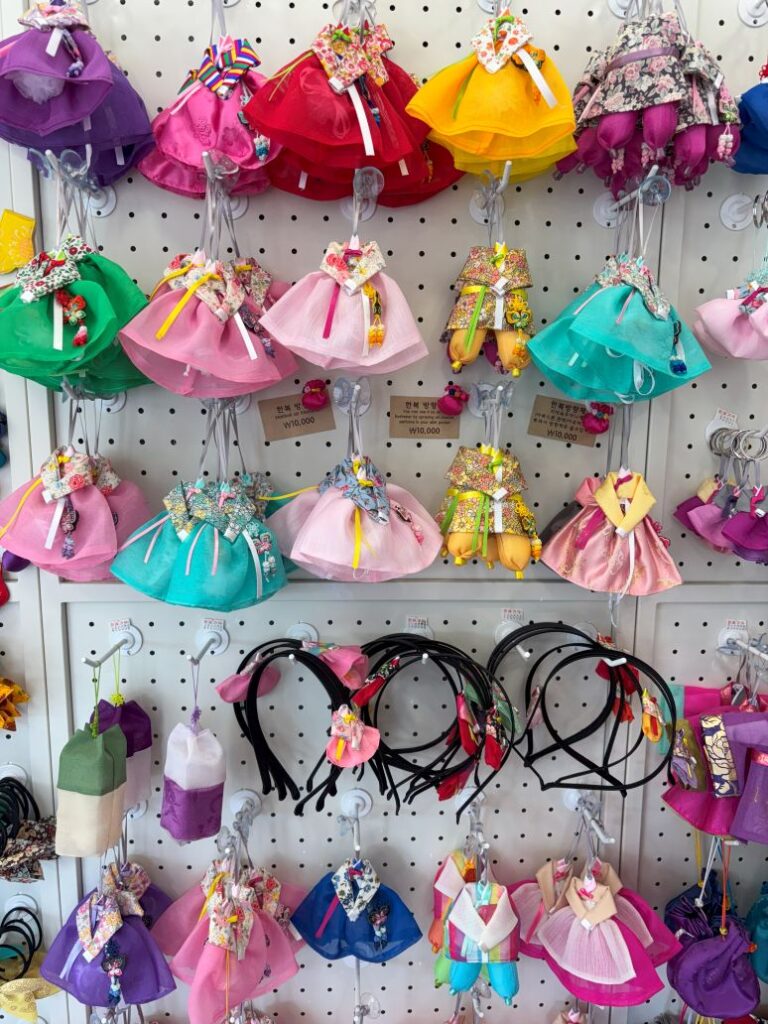
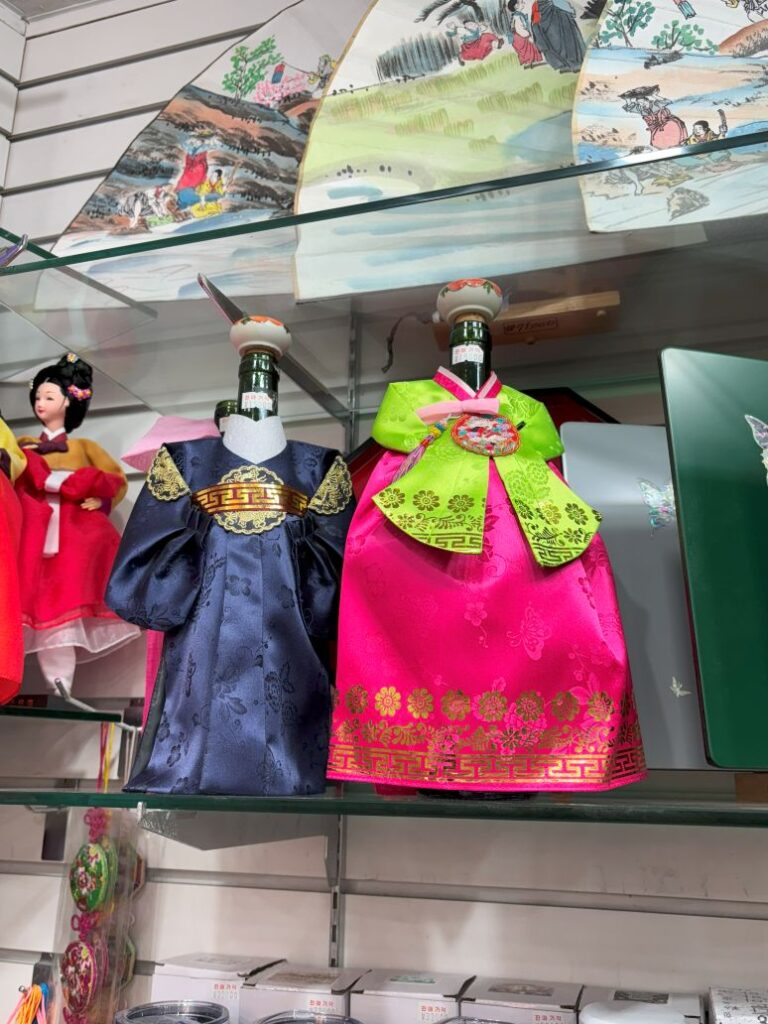
Name Stamps
Korean name stamps, known as “dojang,” are custom-made seals traditionally used in place of signatures on documents, letters, artworks, and more. Crafted from materials like wood, stone, or metal, each stamp is engraved with the owner’s name in Korean script. Valued for their significance, dojangs make thoughtful and symbolic gifts, particularly for milestones such as weddings, graduations, or professional achievements.
These name stamps are unique souvenirs from South Korea, as well as neighbouring countries such as Taiwan and Japan.
Cost of Dojang: 20,000 – 50,000 KRW (US $15 – 35)
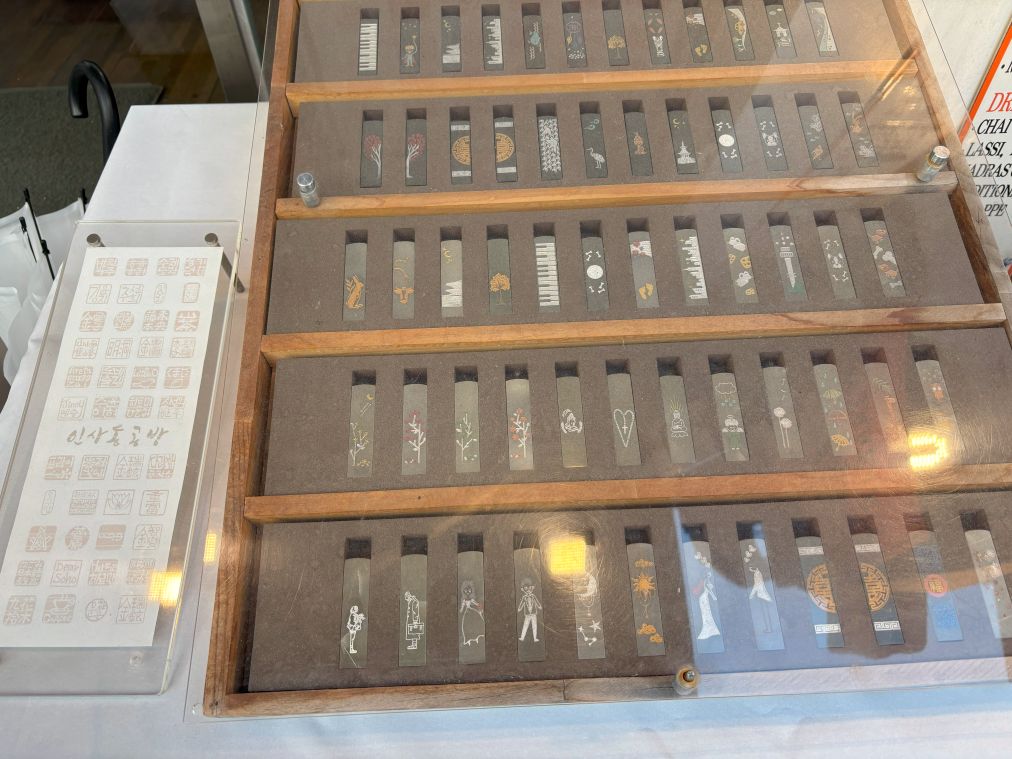
Ceramics
Korean ceramics, especially the beautiful Cheong-ja or blue-and-white porcelain, have deep roots going back to the Joseon dynasty. These timeless pieces are known for their elegant cobalt blue artwork painted on smooth white porcelain.
You’ll often spot delicate scenes of nature – graceful birds, blooming flowers, peaceful landscapes, as well as powerful symbols like dragons and phoenixes that are believed to bring good luck. If you’re into collecting something uniquely Korean, these ceramics are full of history and charm. Perfect as a classy souvenir from South Korea or a meaningful and useful gift!
Cost of Ceramics: 1,00,000 – 2,75,000 KRW (US$75 – 200)
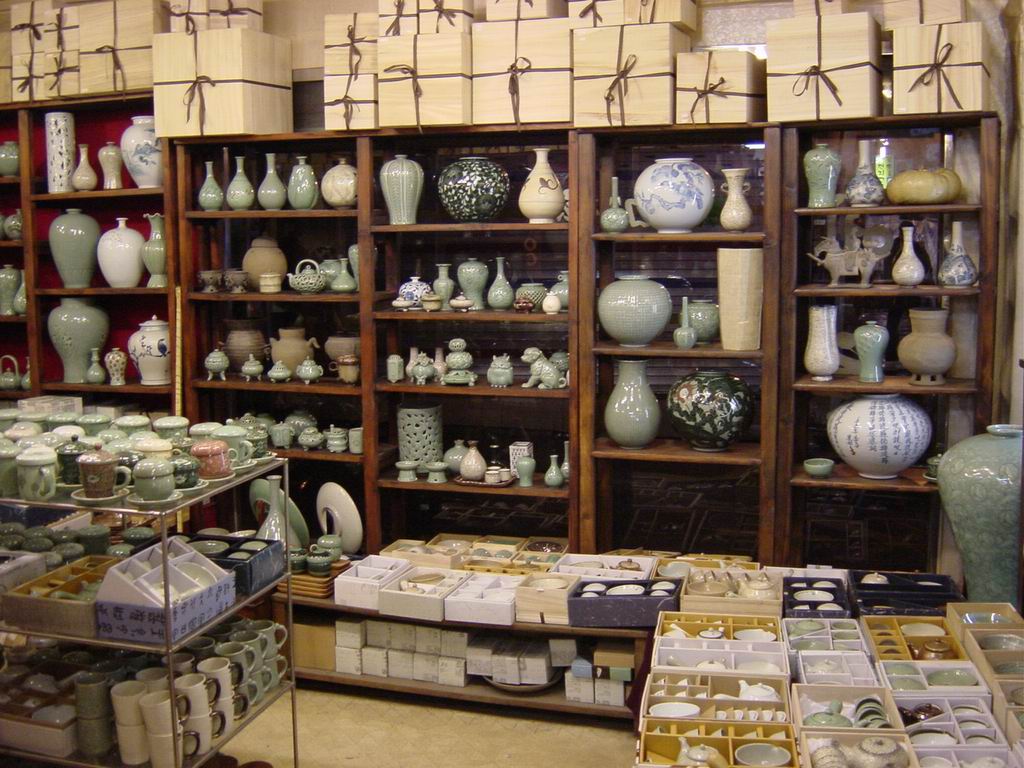
Korean Rice Cakes (Tteok)
Tteok is to Korea what Mochi is to Japan!
Tteok are Korean rice cakes that are chewy and tasty. Made by steaming glutinous rice flour and shaping it into different forms, tteok is filled with various fillings or dunked in spicy sauce. Hence, it comes in both sweet and savoury varieties – so there’s something for everyone!
Tteok is often served at weddings, birthdays, and big holidays like Lunar New Year because it’s more than just food—it symbolises prosperity, long life, and good luck. It is also distributed during the opening of a new shop to gather good luck.
Cost of Tteok: 2,000 – 4,000 KRW (US$1.50 – 3)

Soju
After watching countless K-dramas and watching countless scenes of actors gulping soju, I had to try it myself. And that’s literally what I did as soon as I reached Korea – Korean lunch with soju.
Soju is Korea’s most popular alcoholic beverage, often referred to as ‘Korean vodka’. Soju is deeply ingrained in Korean drinking culture and is often enjoyed during social gatherings and celebrations. It has a neutral taste with a subtle sweetness and can be consumed straight or used as a base for cocktails. Soju combined with beer in the ration of 3:7 makes for a popular cocktail called somaek which is another popular beverage in Korea.
There are many flavoured soju available and I found grapefruit and lemon flavour to be the best of all and I carried them home!
Cost of Soju bottle: 1,900 – 2,000 KRW (US$1.3 – 1.5) in convenience stores and 5,000 – 7,000 KRW (US$ 3.5 – 5) in restaurants.
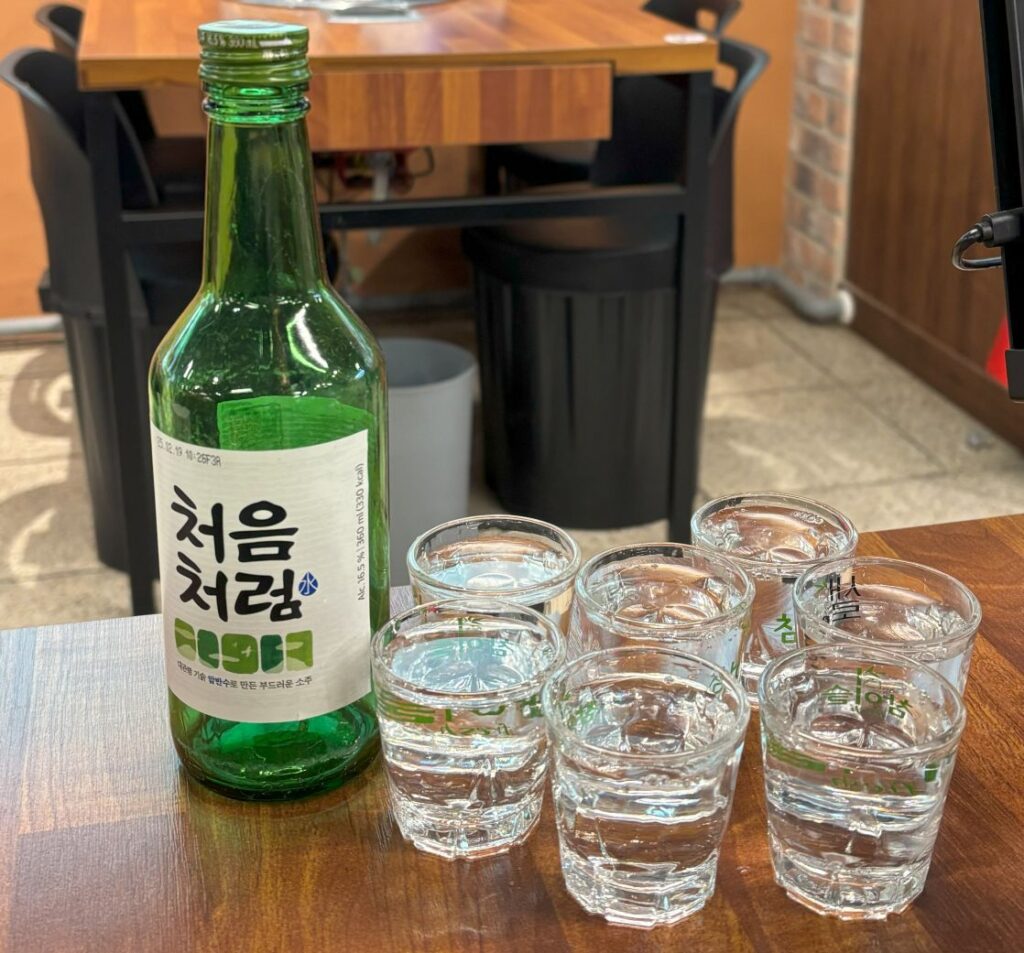
Gim
Gim, Korea’s beloved roasted seaweed snack, is light, crispy, and oh-so-addictive! Usually seasoned with sesame oil, salt, and sometimes a kick of spice, gim isn’t just a side dish, it’s a go-to munchie for movie nights or a flavorful crunch alongside rice and soup. You’ll find it in every Korean household and every convenience store. It’s healthy, tasty, and super easy to carry home, making it one of the best food souvenirs from South Korea.
Cost of gim packet (10 sheets): 1,400 -2,000 KRW (US$ 1 – 1.5)
Gochujang sauce
If you have had meals in Korea and your country, you are probably aware of Gochujang sauce – the fiery red, tangy, spicy and sweet paste. Found in a lot of Korean cuisines, it is a beloved sauce, making it one of the best souvenirs from South Korea to carry back home.
Gochujang is a red chilli paste, which is a thick, fermented condiment that blends spicy, sweet, and umami notes in a way that instantly elevates dishes like bibimbap, tteokbokki, sundubu-jjigae and marinades. Made from red chilli powder, glutinous rice, fermented soybeans, and salt, gochujang is a staple in Korean households.
It comes in compact, travel-friendly tubs or beautifully packaged jars, making it a practical and flavorful gift for food lovers or a great way to bring a little Korean heat into your kitchen.
Note: While most gochujang sauce is vegetarian, some of them may have shrimp paste and/or fish oil. Read the ingredients before buying. Use Google Lens to translate the jar ingredients.
Cost of Gochujang sauce: 7,000 – 15,000 KRW (US$7 – 10)
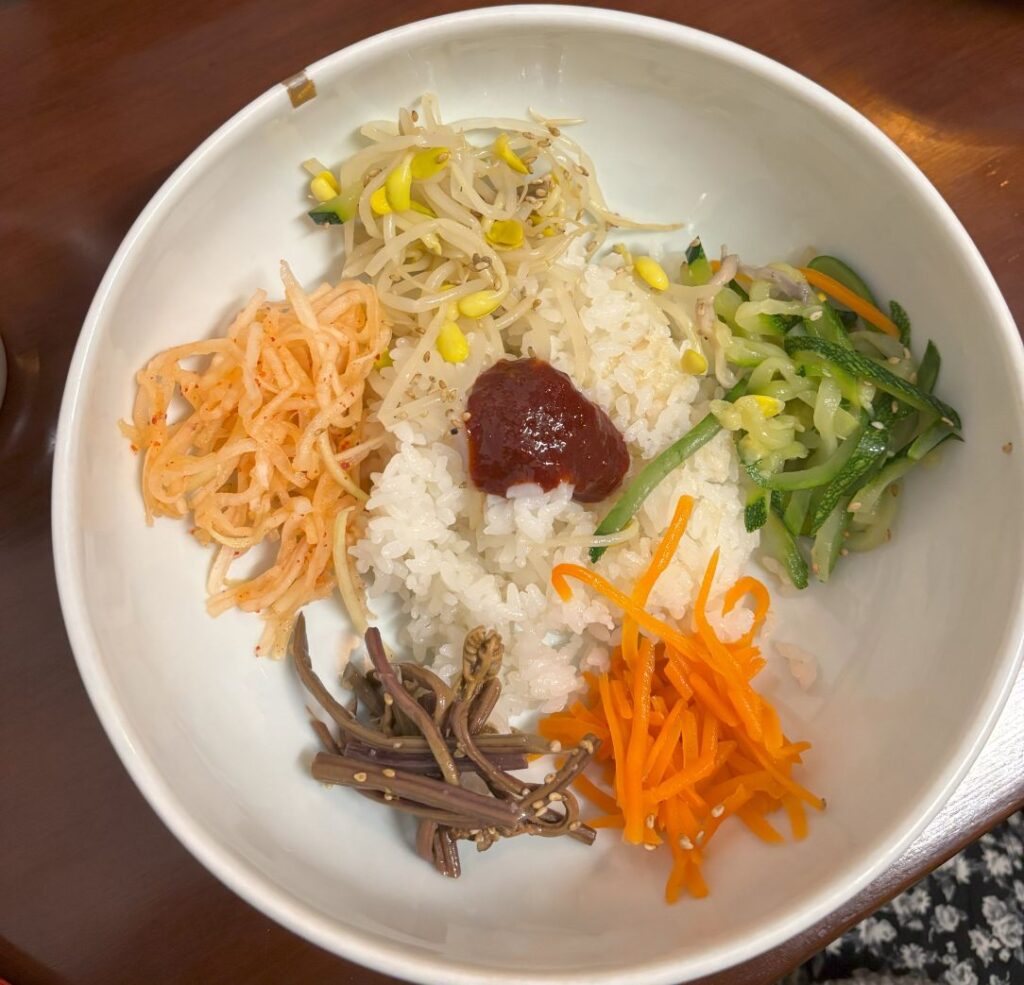
Makgeolli
Makgeolli, Korea’s beloved traditional rice wine, is a creamy, slightly fizzy drink with a sweet-and-tangy flavour that’s both refreshing and comforting.
Made from fermented rice and water, it’s got a soft milky appearance and a gentle kick, kind of like the perfect middle ground between beer and yoghurt (in the best way possible!). Locals often pair it with savoury pancakes like pajeon or spicy dishes, especially on rainy days.
Whether you’re at a bustling market or a cosy countryside pub, sipping Makgeolli is like tasting a piece of Korean tradition in a bowl. And to be honest, I like Makgeolli better than Soju. So much so that I wanted to get a few bottles, but I did not want to take the risk with a fizzy drink on a 12-hour flight back home. But if you are brave, go for it!
Cost of Makgeolli bottle: 1,600 – 2,000 KRW (US$1.1 – 1.5)

Wedding Ducks
In Korean culture, wedding ducks, also known as “wedding mandarin ducks”, are more than just cute decor; they’re heartfelt symbols of love, loyalty, and lifelong partnership.
Since real mandarin ducks are known to mate for life, they’ve long represented marital harmony and faithfulness. These charming little ducks, often beautifully hand-carved from wood or stone, are traditionally given as wedding gifts to bless the newlyweds with a joyful and lasting union.
Cost of wedding ducks: 20,000 – 1,00,000 KRW (US$14 – 75)
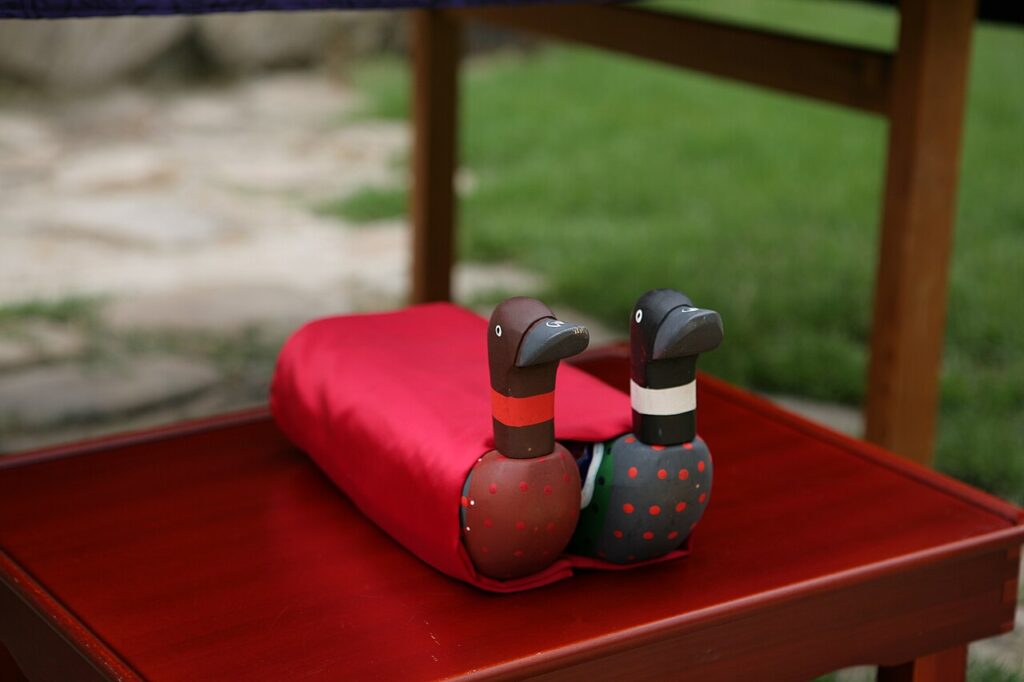
Customised keychains and phone charms
Customised keychains make for charming and personal souvenirs from South Korea, offering a fun way to carry a piece of your trip wherever you go. From cute Korean characters like Kakao Friends and BT21 to keychains featuring your name in Hangul, traditional symbols, or even miniature food replicas like kimchi and tteokbokki, there’s something for every taste. You can easily find stalls and stores in popular areas like Myeongdong or Insadong that engrave names or initials on the spot, turning a simple trinket into a meaningful keepsake or a thoughtful gift.
Cost of keychains: 5,000 – 15,000 KRW (US$3.5 – 10)
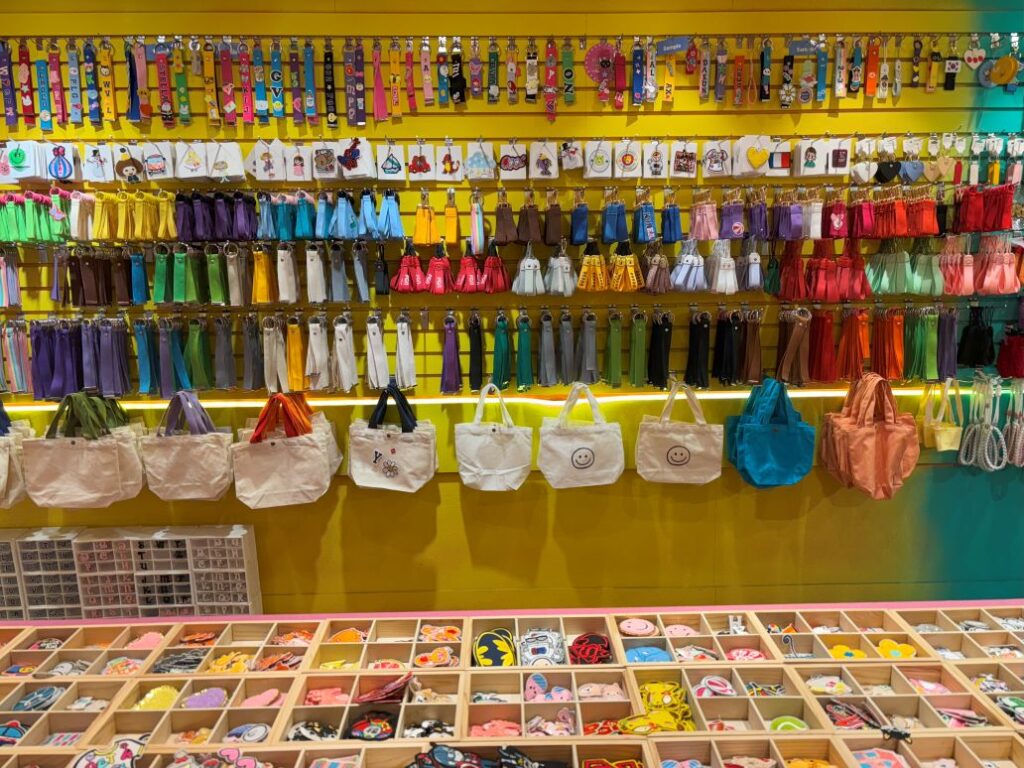
Stationery & Stickers
Buying stationery and stickers in South Korea is a delightful experience, especially for those who love cute, creative, and high-quality paper goods. Korean stationery is known for its playful designs, vibrant colours, and attention to detail, featuring everything from adorable animal characters and K-pop themes to elegant minimalist styles.
Stickers, notebooks, washi tapes, pens, and planners are popular items, perfect for journaling, scrapbooking, or gifting. Places like Artbox, Kyobo Bookstore, and local markets in Seoul are treasure troves for these quirky finds, making stationery a fun and practical souvenir that captures Korea’s unique design culture.
Cost of Stationery and Stickers: 1,500 – 15,000 KRW (US$1 – 10)
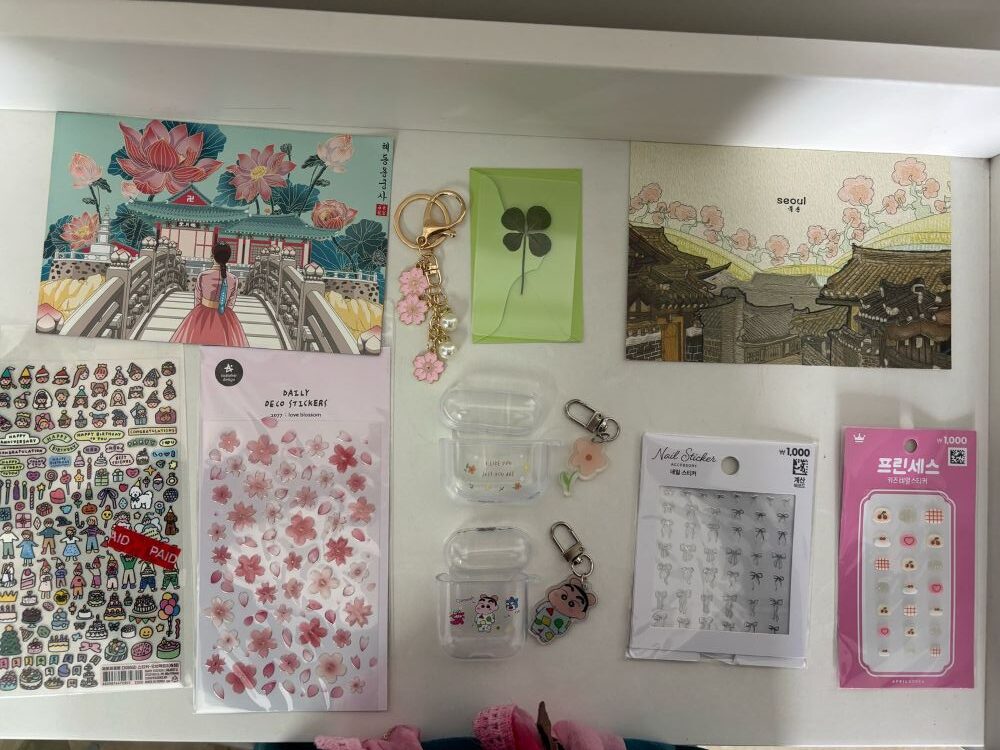
Caricature
Getting a caricature drawn in South Korea is a fun and personal way to take home a truly unique souvenir. Often found in tourist-friendly spots like Insadong or Hongdae in Seoul, Gamcheon in Busan and Dongji-ro in Gyeongju, local artists capture your likeness with a playful twist, exaggerating features or adding quirky elements that reflect your personality or traits.
These caricatures are generally drawn on paper by hand, live and within 5 minutes. The caricature is then framed and handed over.
Cost of caricature: 7,500 – 9,000 KRW (US$5 – 7) for one person
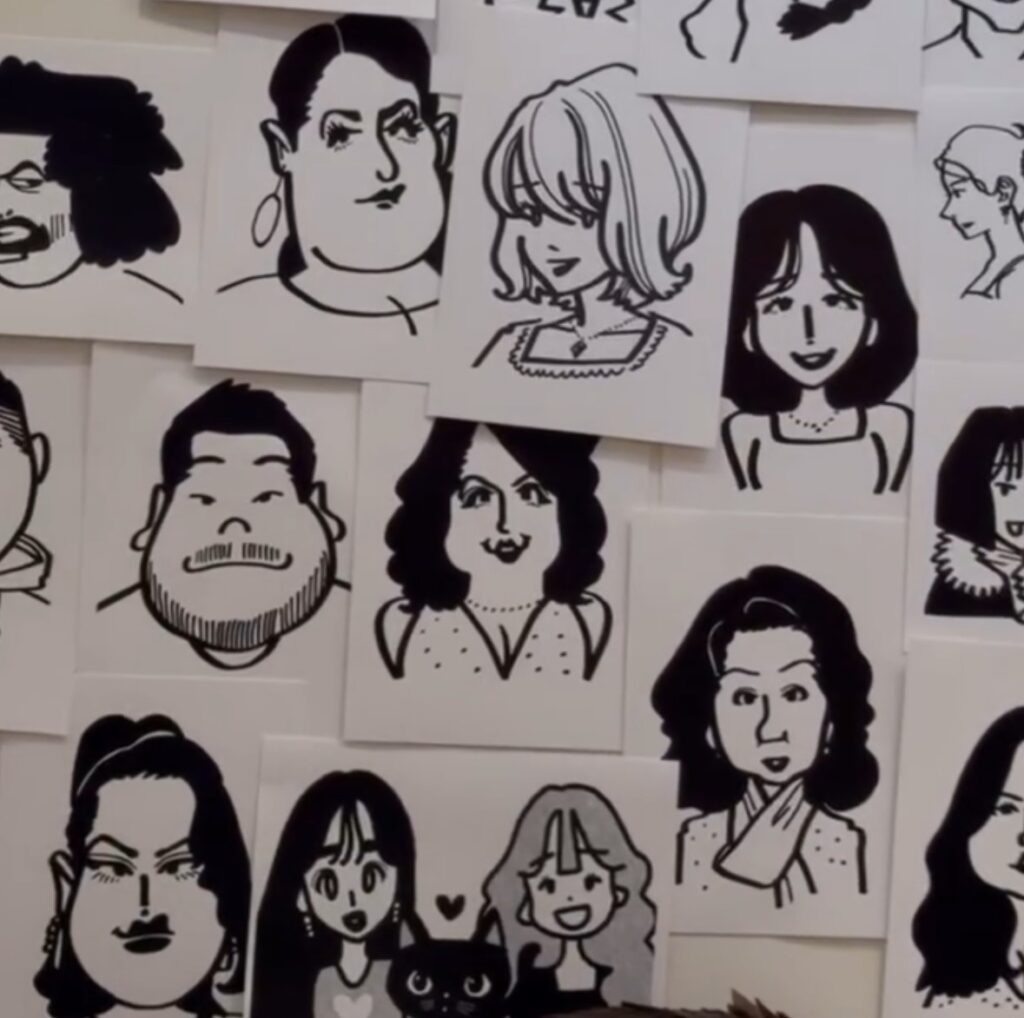
Folding Fans
Korean folding fans, known as buchaeon, are the perfect mix of beauty and practicality. These fans aren’t just for beating the heat; they’re miniature works of art.
You’ll find hand-painted designs featuring serene mountain landscapes, elegant calligraphy, or delicate blossoms that reflect Korea’s rich cultural aesthetic. Lightweight and easy to pack, they’re ideal as thoughtful gifts or as a decorative piece to bring a touch of Korean tradition into your home.
Cost of folding fans: 5,000 – 10,000 KRW (US$3.5 – 7)
Korean Traditional Hand Fans
Korean traditional hand fans are a lovely Korean souvenir to bring home. Crafted from sturdy bamboo and hanji (Korea’s traditional handmade paper), these fans are a beautiful blend of simplicity and elegance.
You’ll often find them adorned with delicate patterns inspired by Korean folklore, nature, and classical art. Not only are they super lightweight and easy to pack, but they also add a touch of cultural charm to any space.
You can even pick plain ones and colour them yourself after going back home
Cost of Korean traditional hand fans: 5,000 – 10,000 KRW (US$3.5 – 7)
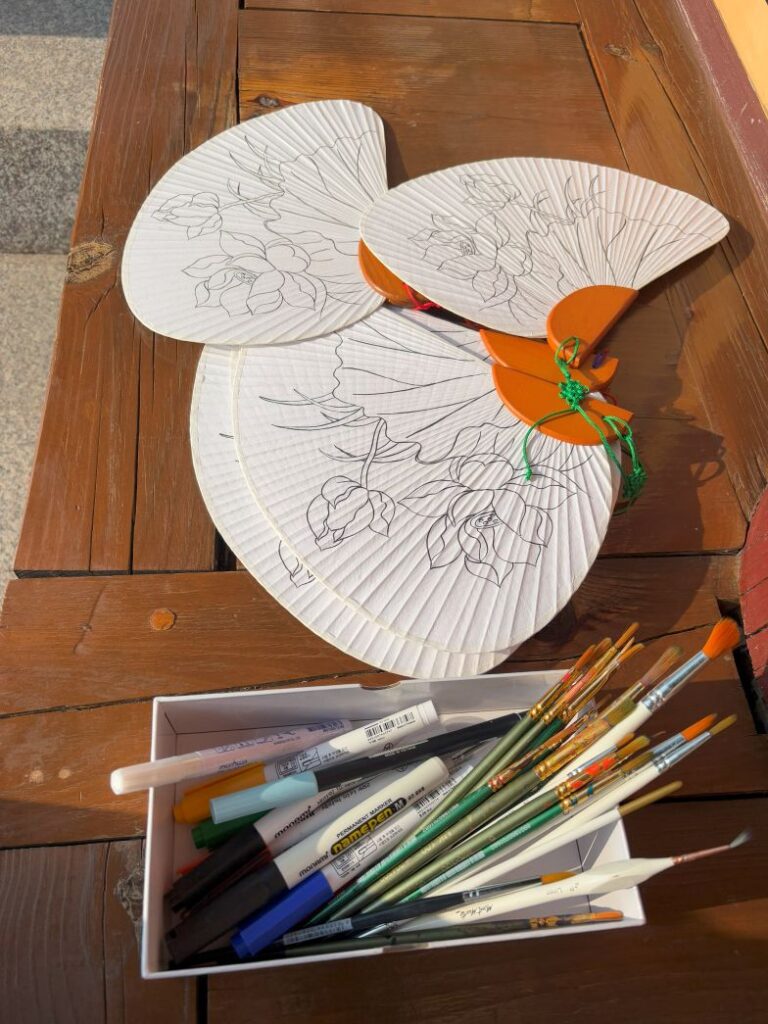
Norigae
Norigae, a traditional Korean accessory, makes for a unique and elegant souvenir that reflects the country’s cultural heritage. Norigae is hung on the goreum (coat strings) of a woman’s hanbok and functions as a decorative pendant. Each design carries its meaning and is considered a good-luck charm hoped to bring something such as eternal youth, wealth or many sons (depending on its shape).
Norigae features intricate knots, colourful silk threads, and symbolic charms like butterflies, peonies, or jade.
Cost of Norigae: 25,000 – 1,40,000 KRW (US$ 20 – 100) while some norigae with rare stones can go up to US$1000.
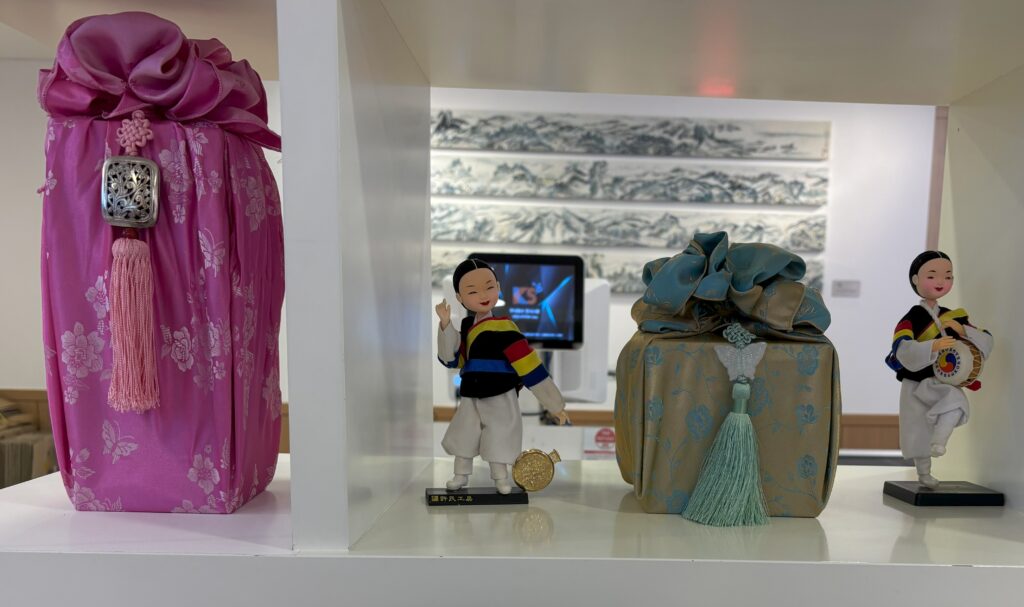
Traditional Korean Silk Coin Purse
Coin purses have been a part of Korean culture since the introduction of Korean currency, traditionally used by women not only for their practicality of storing coins, but also as stylish accessories to complement their hanbok.
These purses were often carefully selected to match or accentuate the colours of an outfit. While modern Korean women rarely use these purses in daily life today, they still appear in traditional ceremonies and remain popular for their aesthetic charm.
Often handmade, these purses feature beautiful Korean floral patterns, come in a variety of vibrant colours, and are crafted from smooth, luxurious silk. A drawstring at the top secures the contents, making them both functional and decorative. They make a thoughtful and elegant gift for any woman who appreciates culturally inspired accessories or enjoys keeping her change in something a little more special.
Price range: 10,000 – 20,000 KRW (US$ 7-14)
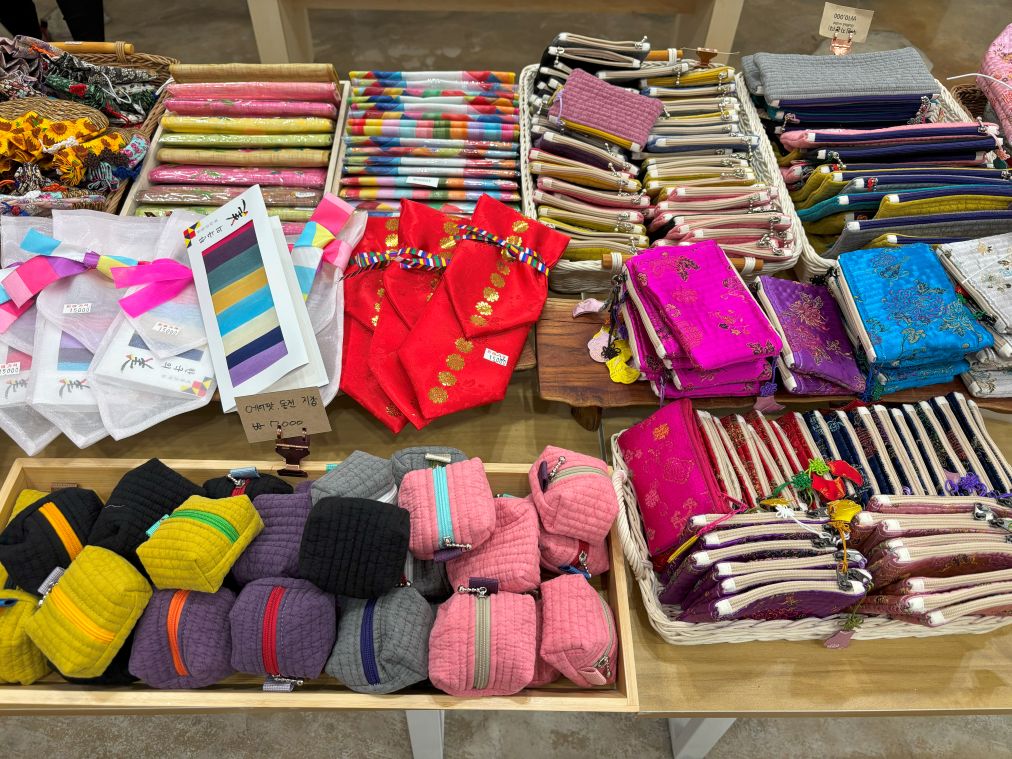
Four-leaf clover
Considered a universal symbol of luck, hope, and prosperity, these rare clovers are a charming and symbolic best souvenirs from South Korea. Koreans often gift four-leaf clovers to friends, classmates, or loved ones to wish them good luck during exams, new jobs, or life transitions. Because they are rare and must be found rather than grown easily, they also represent genuine care and effort, making them meaningful tokens of affection.
These leaves are often carefully preserved in clear resin keychains, bookmarks, jewelry, or pressed into decorative cards. They are sold in boutiques, gift shops, or even stationery stores, making them a lightweight, meaningful, and heartfelt memento.
Price range: 2,000 – 7,000 KRW (US$ 1.5-5)
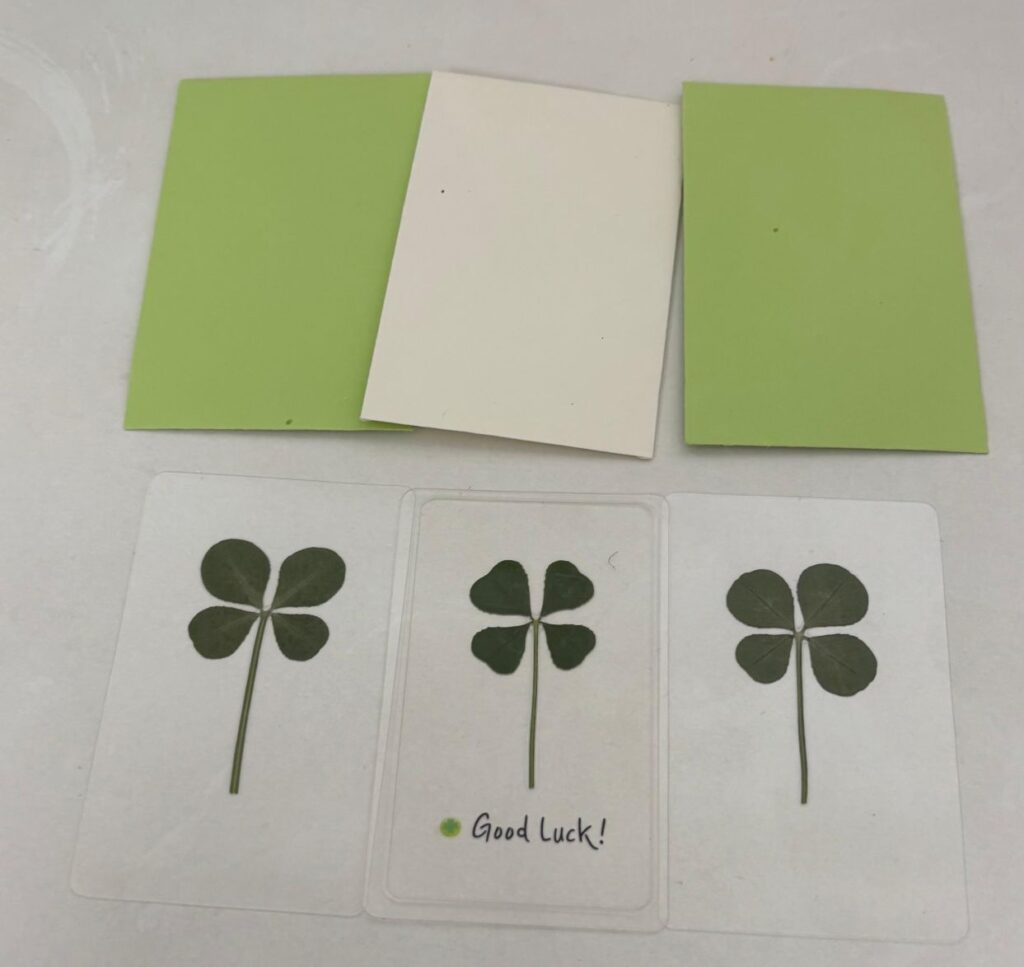
Banana milk
If you have seen K-dramas this is probably something you want to try on your trip to Korea. Instantly recognisable by its small, round, uniquely shaped bottle, it has been going viral for mixing it in an americano and drinking it.
Banana milk is one of South Korea’s most iconic and beloved beverages, making it a quirky and nostalgic souvenir to bring home. This sweet and creamy drink has become a cultural staple for Koreans. The banana milk evokes childhood memories for locals and a unique taste of everyday Korean life for the tourists.
It’s widely available in convenience stores and supermarkets, often in multi-packs that are easy to carry home. Another variant is strawberry milk, but it is not as popular as banana milk.
Price of banana milk: 1,800 KRW (US$ 1.2)
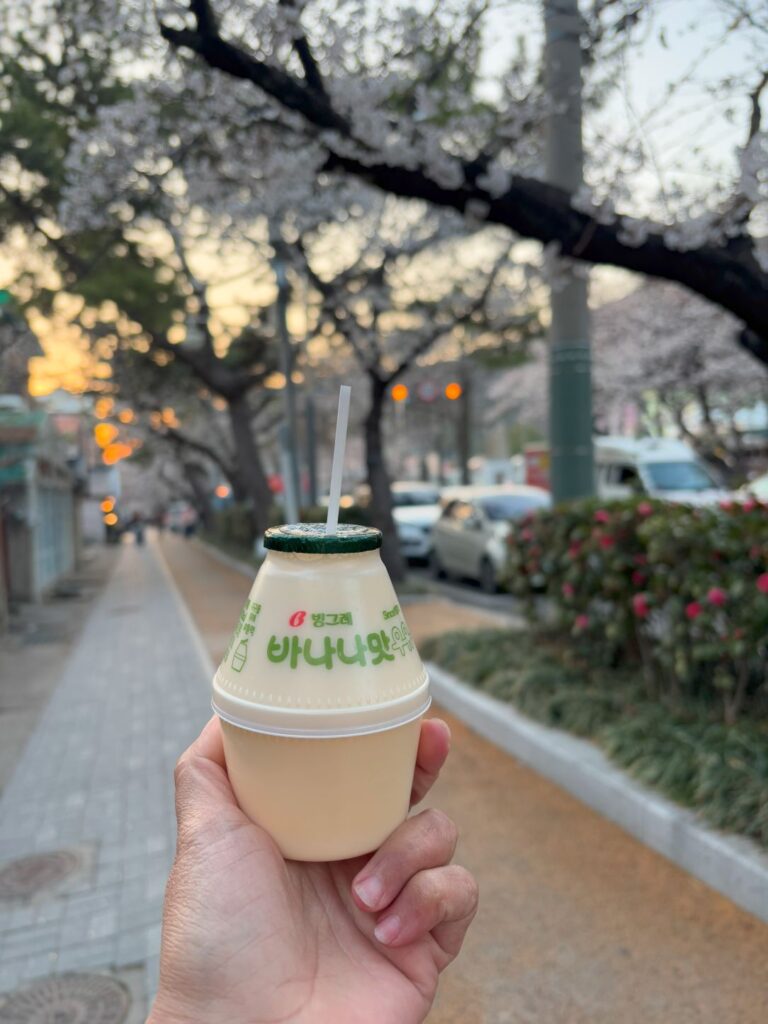
Postcards
Postcards make for simple, meaningful and best souvenirs from South Korea, offering a beautiful way to capture and share memories of your trip.
There is a wide variety of postcards, depending on where you are purchasing them from. They have stunning landscapes like Namsan Tower and Jeju Island, to vibrant snapshots of Korean culture, K-pop icons, traditional hanboks, or historical palaces. Many postcards are artistically designed or even hand-illustrated by local artists, making them feel special and personal. They’re lightweight, easy to carry, and perfect for mailing to loved ones or keeping as mementoes in travel journals or scrapbooks.
You can also mail these to yourself from South Korea to feel nostalgic, yet feel special after the trip is over.
Cost of Korean postcards: 1,000 – 2,000 KRW (US$ 0.75 – 1.5)
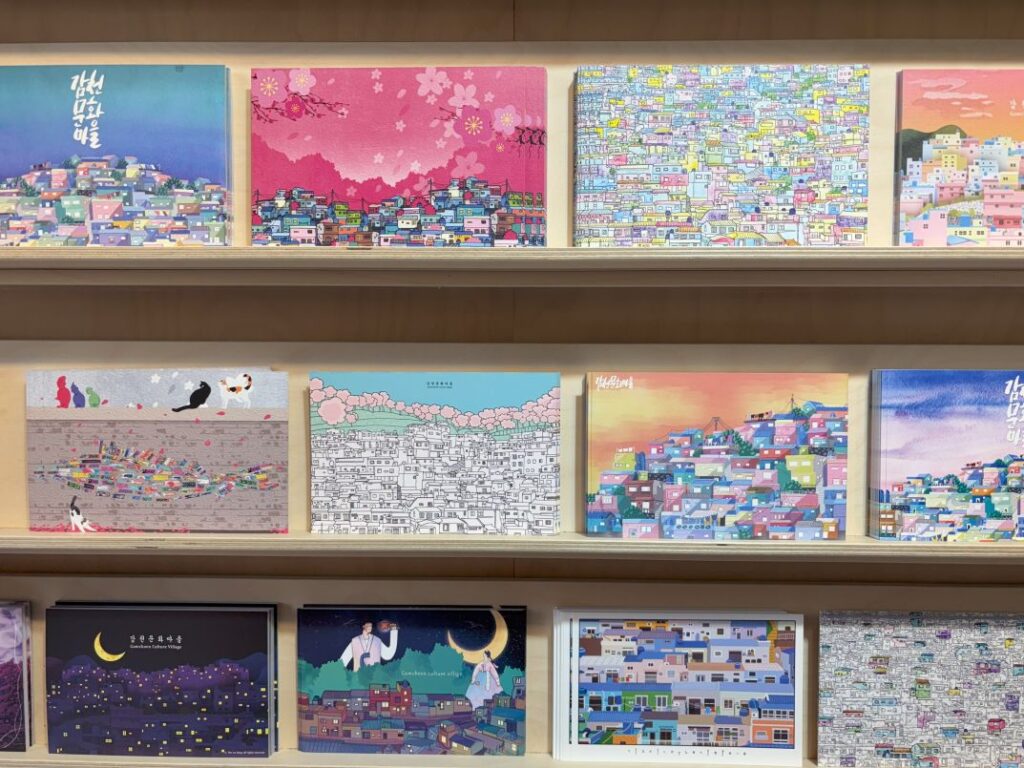
Paper mache boots
Paper mache boots or shoes are miniature boots that are handcrafted from layers of paper and typically decorated with vibrant patterns, floral motifs, and traditional Korean designs.
Though not wearable, they are prized as decorative pieces symbolising good luck and prosperity. Lightweight and eye-catching, these boots are perfect for gifting or as a unique addition to your collection of travel mementoes.
Cost of Korean papier mache boots: 20,000 KRW (US$14)
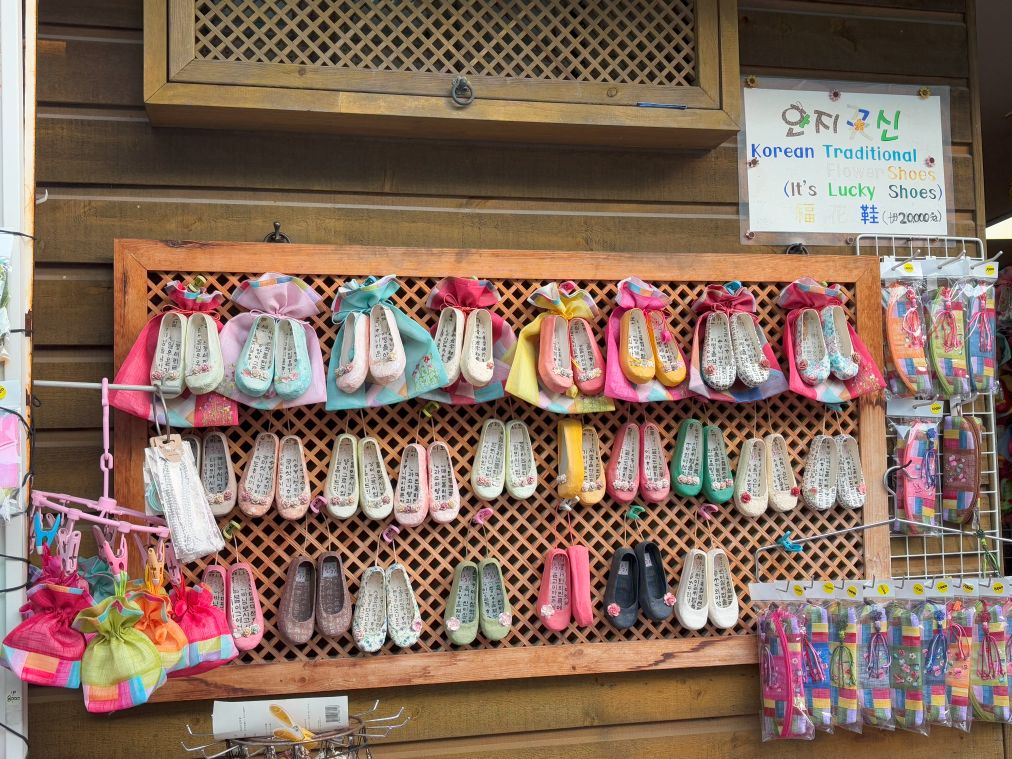
Mother of Pearl products
In Korea, mother-of-pearl is most commonly used to create inlays for lacquered furniture and decorative objects. Such items are known as najeon chilgi in Korean (najeon meaning mother-of-pearl, and chilgi meaning lacquerware) and often depict motifs from nature, such as flowers, birds, and butterflies.
The exterior is crafted from shimmering mother of pearl (nacre), a durable, iridescent material derived from molluscs, which reflects a spectrum of colours depending on the light and angle. Mother of pearl inlay is the practice of inserting mother of pearl pieces into wooden objects such as cases, desks, chests, chairs, mirrors, jewellery boxes, water bottles and musical instruments.
Price of mother-of-pearl products: 30,000 – 500,000 KRW (US$32 – 360)
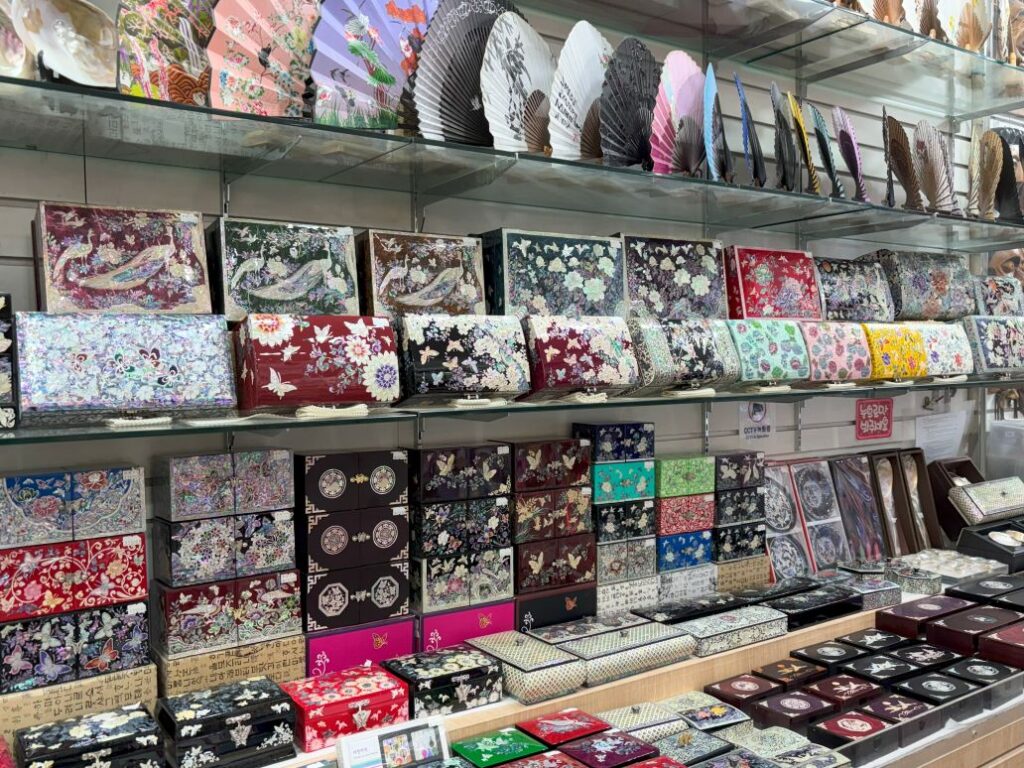
Korean Dolls
Miniature Korean dolls, dressed in vibrant traditional Korean attire, are adorable and make for the perfect keepsake to bring home. These charming dolls come in all shapes and sizes, showcasing the beauty of Korea’s iconic hanbok, from the bright colours and flowing skirts to the tiny, intricate accessories.
Whether you’re into collecting cute figurines or want a meaningful cultural souvenir, these little dolls pack a lot of heritage into a tiny package and look great on a shelf or desk.
Price of Korean dolls: 15,000 – 50,000 KRW (US$ 15-35)
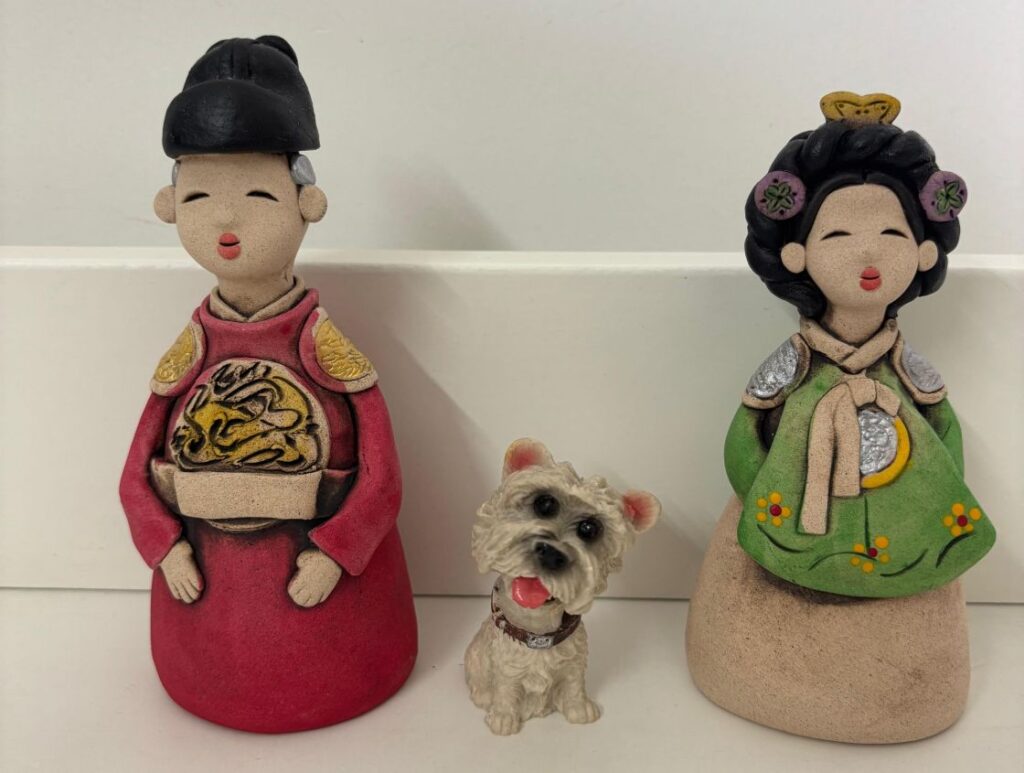
Instant Ramen
Ramen in Korea is known as Ramyeon, and it is sold everywhere. Thanks to k-dramas, having ramen is considered cool or a must-do thing especially in certain areas such as along the Han River in Seoul.
Ramen is a staple food in Korea, but thanks to the advent of instant ramen, it is the go-to food for tourists, students, and even working professionals who want to solve their sudden hunger pangs.
They make for a convenient food option that can be picked up from a vending machine or 7-Eleven stores, add boiling water and consume after letting it sit for a couple of minutes. These cup noodles taste as good as the actual ones in restaurants and that is why it is one of the best souvenirs from South Korea.
They are conveniently packed in a cup and do not take up space in the bag. If you want it to taste like a fresh ramen bowl, add fresh ingredients like fresh veggies and boiled egg while cooking.
While ramen flavouring has beef in it, there are now options for soy-flavoured vegan cup ramen. Although it is difficult to read the ingredients and know if the ramen cup you are buying is vegetarian, it is best to ask the staff about it or shop for it with a local, as store staff may not be able to converse in English. I found one ramen cup which was green in colour that was vegeterian.
There are Ramyun libraries and even self-service ramen stores that are open for 24 hours in Seoul. They offer hot water, heating stations and even fresh ingredients to add to the ramen.
Price of Ramen: 700 – 1,500 KRW (US$ 0.5 – 1)
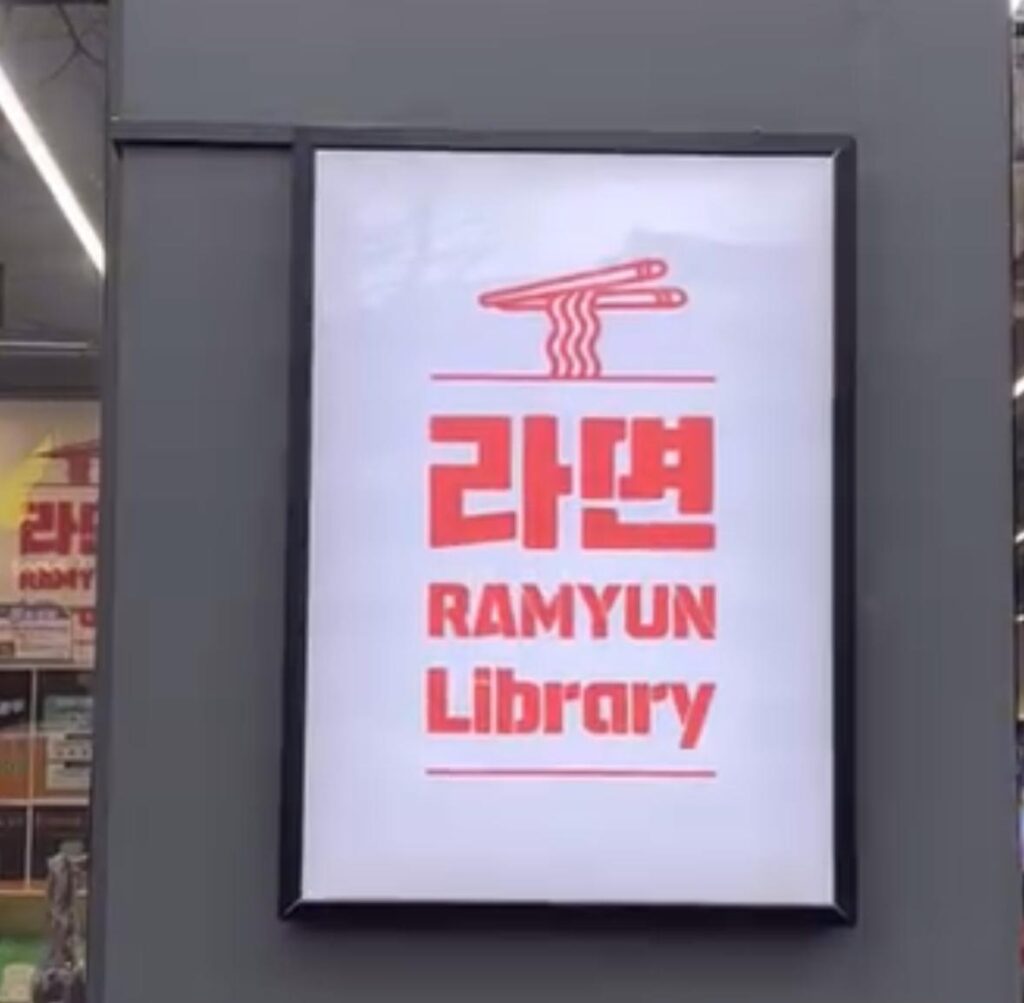
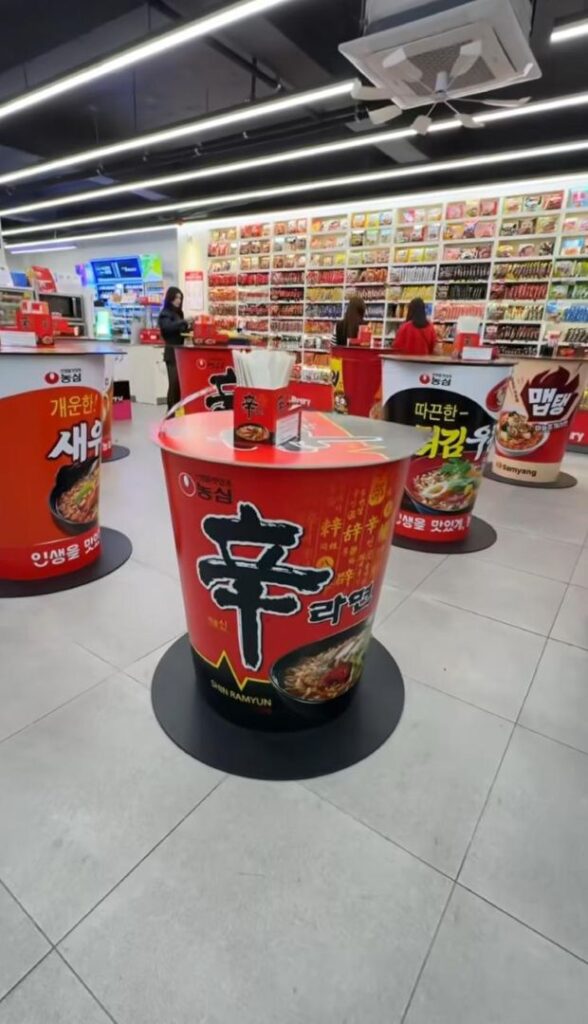
WHERE TO PURCHASE KOREAN SOUVENIRS | BEST SHOPPING DISTRICTS IN KOREA
South Korea boasts several popular shopping districts. The following recommendation is based on where I went during my very short time in South Korea. I have covered 3 cities and various shopping places there.
Best places to shop souvenirs in Seoul
What to buy in Seoul and where to buy in Seoul is always a question. Here’s me, answering that for you!
Myeongdong
Myeongdong is the most popular and hence the most touristy place in Seoul. Myeongdong is a lively shopping district in the heart of Seoul, buzzing with people and offering a variety of food, shops, and souvenirs. Shops are typically open from 10:00 am to 10:00 pm.
Known for its vibrant atmosphere, the area is filled with cosmetic stores, fashion boutiques, and international brands. It’s a paradise for K-beauty fans and fashion lovers, offering trendy clothing and a chance to experience the Seoul Myeongdong Nanta Musical Show.
While strolling through the streets, you’ll often find stores offering freebies or free skin analysis, and there are also flea markets and fashion boutiques that provide affordable shopping options.
Myeongdong houses many Korean beauty flagship stores here, so it’s the perfect place to pick up skincare essentials, as well as Korean cosmetics gift sets. These pre-packaged sets are perfect for gifting and include a variety of skincare or makeup products from popular brands like Innisfree, Etude House, and Laneige.
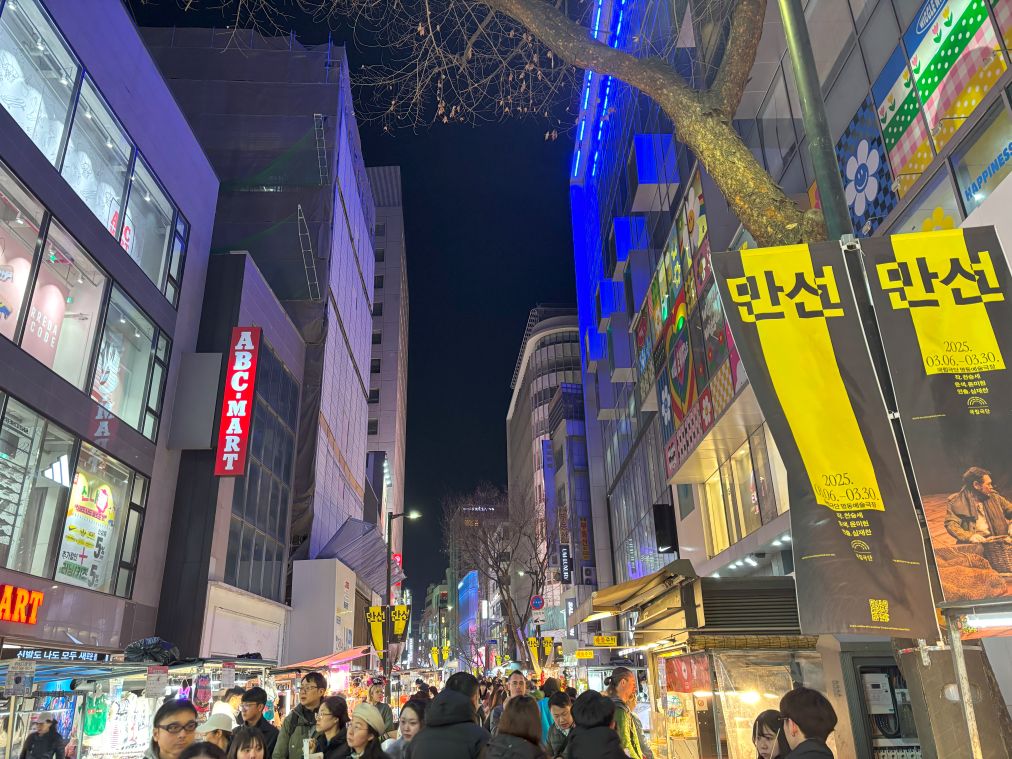
Dongdaemun
Dongdaemun, one of Seoul’s most energetic shopping districts, is especially famous for its thriving fashion and textile scene. Known for its 24-hour shopping culture, it draws style-savvy locals and tourists alike. The area is a hotspot for fashion lovers and designers, offering everything from wholesale fabric markets to cutting-edge boutique showrooms.
Insadong
Insadong is celebrated as a hub for traditional Korean culture. Once a district frequented by royalty, a stroll through its cobblestone streets lined with charming Hanok houses feels like stepping back in time.
On weekends, the area transforms into a lively cultural zone, free of car traffic, where visitors can enjoy classical music performances, art displays, and mouthwatering Korean street food.
Known for its artisanal shops, Insadong is the perfect place to find authentic Korean crafts like pottery, paintings, and hanbok. Art lovers and curious wanderers alike will appreciate meeting local painters and craftsmen sharing their work and stories.
Hongdae
Hongdae bursts with youthful energy and creativity, making it one of Seoul’s trendiest hotspots. Known for its thriving indie music scene and artsy atmosphere, this neighborhood is packed with offbeat boutiques, stylish fashion shops, and street stalls offering handmade crafts and accessories. It’s also a hub for nightlife and spontaneous street performances, with hip cafes and bars lining the streets, perfect for anyone looking to experience Seoul’s modern, youthful vibe.
Gangnam
Shopping in Gangnam, offers a sleek, upscale experience that reflects the district’s glamorous reputation. Known for its luxury boutiques, designer flagship stores, and sprawling underground shopping malls, Gangnam is a paradise for fashion lovers and trendsetters.
The COEX Mall, one of Asia’s largest underground malls, is a must-visit with everything from global brands to Korean beauty products, a massive bookstore, and even an aquarium.
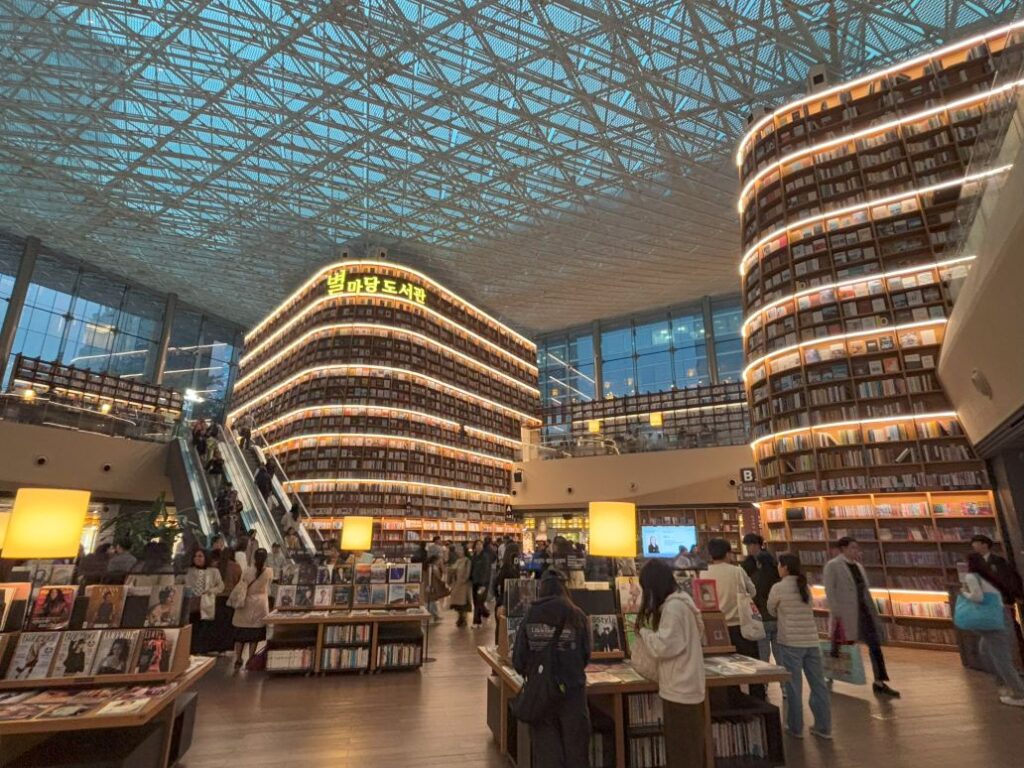
Best places to shop for souvenirs in Busan
Busan offers a fantastic blend of modern charm and traditional culture, and there’s no better way to take a piece of the city home than with unique souvenirs. Whether you’re into local crafts, quirky art, or tasty treats, these three shopping spots are must-visits:
BIFF Sqaure
Located in the heart of Nampo-dong, BIFF Square is not just a cultural hotspot for film lovers, it’s also a bustling place to pick up fun and affordable souvenirs. You’ll find rows of street stalls and shops selling K-pop merchandise, handmade accessories, and Busan-themed trinkets. It’s the perfect spot to grab T-shirts, postcards, and movie-themed memorabilia.
Tiny shops tucked into the alleys sell handmade keychains shaped like Korean food (mini tteokbokki or bibimbap bowls)—fun and quirky keepsakes.
Gamcheon Cultural Village
Known as the “Machu Picchu of Busan,” this colorful hillside village is full of charm and creativity. As you wander its winding alleyways, you’ll come across small art shops and galleries where local artists sell handcrafted goods, quirky figurines, postcards, and accessories. The village itself is like a giant open-air gallery, and picking up a souvenir here feels like bringing home a piece of Busan’s artistic soul.
Local artists sell one-of-a-kind postcards here with hand-painted village scenes or inspirational quotes in Korean. Many will personalize them for you on the spot.
Haeundae Traditional Market
Just a short walk from Haeundae Beach, this traditional market is a great place to experience Busan’s local flavors and find food souvenirs. Think dried seafood, local spices, traditional Korean snacks, and homemade side dishes like kimchi. You can also find small trinkets and kitchenware, often at bargain prices. It’s a more laid-back alternative to bigger tourist markets and offers a taste of local life along with your souvenir shopping.
Best places to shop for souvenirs in Gyeongju
When exploring the historic city of Gyeongju—often called “the museum without walls”, small alleys are filled with knickknacks and food souvenirs.
Dongji-ro, Gyeongju
This particular road has all the souvenirs that you read above – caricature shops, k-beauty, snacks, cutlery and everything else. The shops are small and in many cases hanok style to give that UNESCO theme to the entire area.
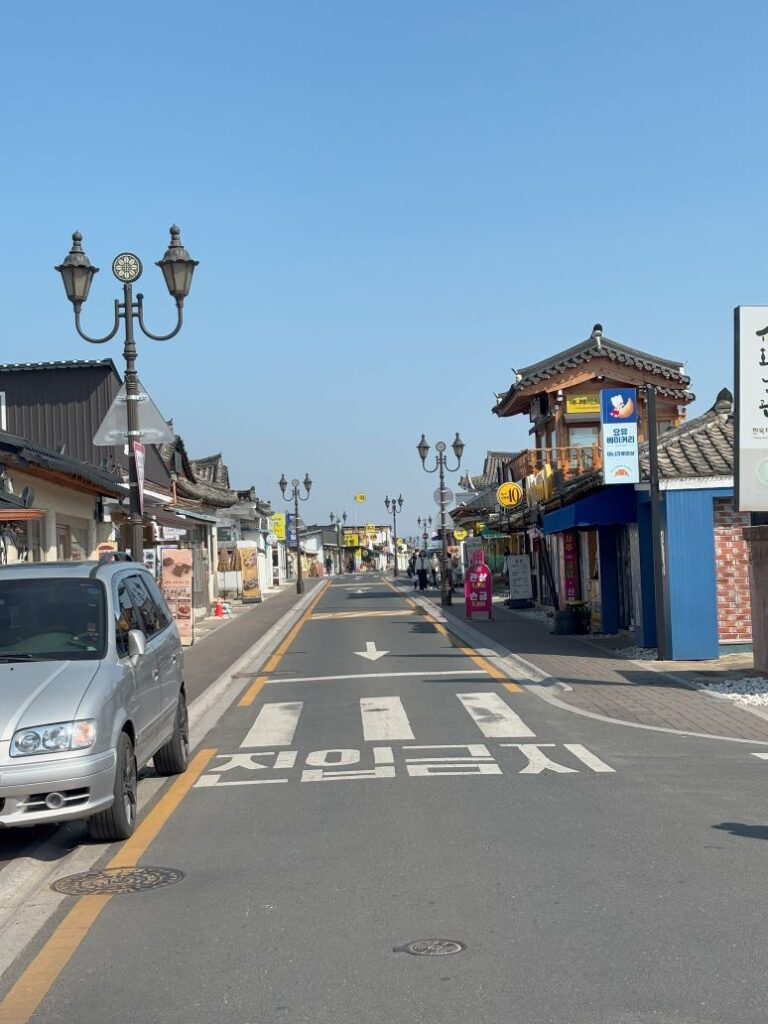
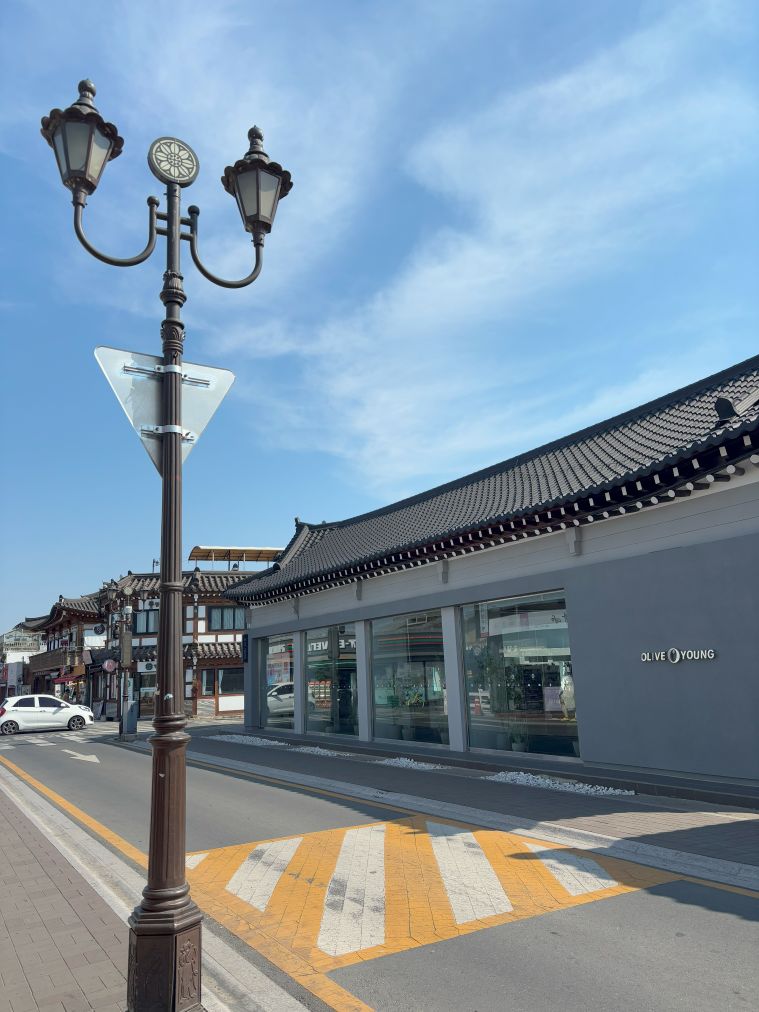
BEST SOUVENIRS FROM SOUTH KOREA: TIPS & TRICKS TO BUY
No matter where you travel, the rules of shopping and bargaining remain the same. Here are some of the tips and tricks to remember for souvenir shopping in South Korea.
Buy Local
Make sure that the product you like and buy is locally made. Don’t buy something that you would get in your country for the same or cheaper price!
The bargain game
The shopkeepers know tourists are going to bargain so the prices are anyway increased by a huge margin. So slash the prices by 20-30% and agree to pay 60-70% of the price. Negotiate hard by simply walking away. If the price is possible for them, they will call you back and give you a counteroffer.
If you buy in bulk, they will give you a better discount. This works better in flea market or street market.
Beware of custom restrictions
Certain products may be restricted due to potential plant diseases and animal health concerns. It is best not to carry them.
Timing is Key
Know the timings of night markets! I was told the night markets are open till 1 am in Myeongdong but 50% of shops were shut by 11:30 pm. Allow yourself plenty of time to explore the shops and make purchases.
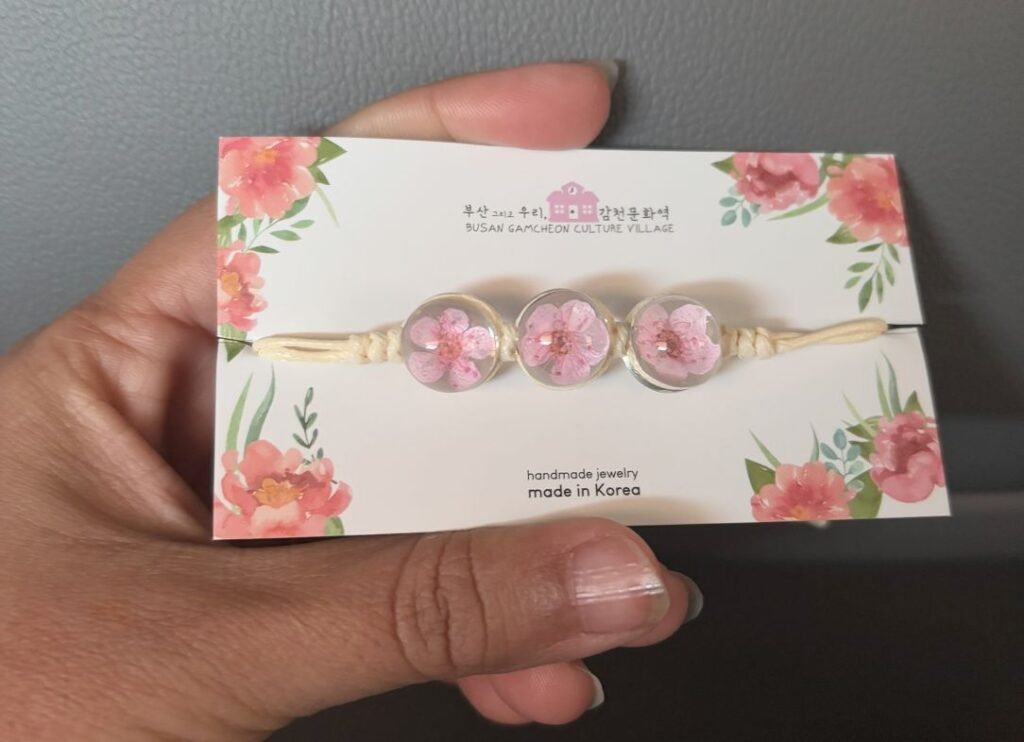
SOUVENIRS FROM SOUTH KOREA FAQs
What to buy at Incheon Airport?
All the international airports in South Korea including Incheon International Airport, Gimhae International Airport, Gimpo International Airport are convenient for purchasing souvenirs, and that last-minute shopping for friends. Travelers can find a variety of popular food and snacks treats, mother-of-pearl inlay work products, tea sets, perfumes and korean skincare.
In case you are short on time or have just in the airport for layover, you can still purchase so many things on app that is pre-paid and on sale and simply collect ot from designated areas.
What are the must-buy souvenirs in South Korea?
South Korea boasts an incredible variety of must-buy souvenirs. K-beauty such as skincare and make-up is a must buy souvenir from South Korea. For food lovers, the top picks include ramen, soju, ginseng and tteok. Traditional handicrafts, such as norigae and hanbok, are timeless and iconic keepsakes.
Where is the best place to buy souvenirs in South Korea?
Metro underground stations, walking streets, night markets and airports!
SUSTAINABLE TIPS FOR SHOPPING IN SOUTH KOREA
- Avoid buying leather bags and artefacts. Try to buy textile-based local products.
- Carry a bag while shopping and avoid plastic bags.
- Encourage shopkeepers to pack fragile items in a newspaper instead of bubble wrap.
- Be polite to the shop owners. In case you don’t buy anything from there, smile at them and say ‘Kamsahamnida’ (thank you) before leaving.
Read More posts about Souvenirs from around the world
- Souvenirs from Kutch, Gujarat
- Souvenirs from Jaipur, Rajasthan, India
- Food souvenirs from Tokyo, Japan
- Souvenirs from Vietnam
- Souvenirs from Uzbekistan
- Souvenirs from Taiwan
I hope this shopping guide on Best Souvenirs from South Korea is helpful to you. If you found this blog helpful, leave a comment to let me know what you purchased.
Disclaimer – This post contains affiliate links. It means it adds no extra cost to you if you book through the link but I get a referral bonus which helps me earn a little to keep this website up and running.
Pin this post!
